How to Give a Presentation in Chinese?
From the Beginning to the End: How to Give the Perfect Presentation in Chinese
Written by Juliette Pitt
Giving a presentation can be nerve-racking in any language, especially if it is in Chinese! But not to worry, you’ve come to the right place, here are a couple of tips that can help you guide you to deliver the perfect presentation to your fellow colleagues!
#Opening
When opening your presentation in Chinese, remember to start by expressing thanks to the host of the event and to the previous speakers. If you are at an event or meeting that has distinguished guests, it is also worth expressing thanks to them too.
For example, a good way to start is:
- 尊敬的……,女士们,先生们,下午好! 我对……表示感谢。(zūnjìng de……, nǚshì men, xiānshēng men, xiàwǔ hǎo! wǒ duì……biǎoshì gǎnxiè)
After this it is usually good to introduce yourself and express which department you represent.
For example, you can say:
- 我是…,请允许我代表…。(wǒ shì…, qǐng yǔnxǔ wǒ dàibiǎo…)
Unlike in the West where perhaps one only says your name, it is best when delivering your presentation in Chinese to add a bit more and perhaps say a couple of words of who you are speaking on behalf of.
You could even go as far as to praise the previous speaker by remarking on their content.
For example, you could say:
- 他/她的发言条理清晰。(tā/tā de fǎyán tiáolǐ qīngxī)
After all the pleasant introductions, it is best to go straight into your intended speech. Our advice to you would be to avoid using humour , unless you are familiar with a couple of Chinese jokes, but it is best to avoid as some jokes are may be hard to translate and it might cross some cultural barriers.
A good structure to use when giving your presentation is First, Second, Third . It is straight forward and provides your presentation with a good flow.
Here are a couple of key words and sentences that you may find useful to use:
- 本次会议的议题是…(běn cì huìyì de yìtí shì…)
- 首先…(shǒuxiān…)
- 再次…(zàicì…)
- 最后…(zuìhòu…)
- 首先,我们来看一下全球电子商务消费行为的调查结果。(shǒuxiān, wǒmen lái kàn yīxià quánqiú diànzǐ shāngwù xiāofèi xíngwéi de diàochá jiéguǒ)
Congratulations! You are nearly at the end of your speech! To end the talk, it is best to use some highly energetic and heroic words as a form of encouragement to your colleagues!
Also, it is important to summarize your main points and thank everyone for listening and for coming to attend your presentation!
For example, some useful sentences to incorporate towards the end are:
- 最后,我想说的是…( zuìhòu, wǒ xiǎng shuō de shì…)
- 感谢你们对本次会议的大力支持。(gǎnxiè nǐmen duìběn cì huìyì de dàlì zhīchí)
- 希望我们能够借此机会加强沟通。(xīwàng wǒmen nénggòu jiè cǐ jīhuì jiāqiáng gōutōng)
- 要实现这美好的愿景,我们只有埋头苦干。(yào shíxiàn zhè měihǎo de yuàn jǐng, wǒmen zhǐyǒu máitóu kǔ gàn.
So, there you have it, a quick guide on how to give your presentation in Chinese. Remember to stay calm and collected .
Its best to practice your presentation with your colleagues first and perhaps with your Chinese teacher. You could even practice a joke with them or two, to see if they get it!
Good luck! 加油 ! If you have presented a talk or lecture before in Chinese, we’d love to hear all about your experience. Why not comment down below and share some useful tips!

Same great quality, bigger scale.
- Tips and Guides
- Chinese Culture
- Chinese Classes
- Chinese Language
- Hutong School
- Internship China
- Learning Chinese
- Holidays and Festivals
- Business in China
- Work From Home

The Art of Giving Chinese Business Presentations
Ever felt those presentation jitters? You know, the sweaty palms, the racing heart, the sudden urge to fake a contagious illness? Now, imagine doing all that while trying to nail a complex business pitch in Mandarin Chinese. Talk about stress levels rising!
But here’s the thing. Mastering the art of a Chinese business presentation changes everything. It’s your key to unlocking deeper understanding and fantastic opportunities when conducting business in China.
Maybe this is your first time presenting in Chinese, or maybe you’ve already survived a few awkward attempts. Either way, this guide is here to help you tackle those quirks of Chinese company culture and deliver a presentation that’ll impress even the most discerning audience. Get ready to transform your Mandarin presentation skills.
Decoding the Chinese presentation
Okay, let’s face it. Chinese presentations aren’t exactly a carbon copy of the PowerPoint extravaganzas you might be used to, simply because of the key differences between Chinese and Western business cultures . Think less flashy animations and more focus on clear structure and respect for hierarchy. Here’s what sets them apart.
Formality rules
If you normally rock a casual jeans-and-quirky-t-shirt vibe for your presentations back home, it’s time for a cultural switcheroo. Chinese business presentations favor a more formal style in both your attire and your language. Think dress pants, a skirt, and a button-down shirt — professionalism is key.
This doesn’t mean you can’t inject some of your personality, but a touch of modesty goes a long way in Chinese business culture.
Structure is king
Imagine your presentation as a delicious dumpling — it should have a clear beginning (the introduction), a flavorful middle (the main points), and a satisfying conclusion that ties everything together neatly.
Focus on delivering a clear, logical flow of information. This will help your audience follow your train of thought and retain the key takeaways.
Slides: Your Minimalist Best Friend
Forget cramming every fact and figure onto your slides. Chinese presentations lean towards simplicity, with visuals that support your points, not distract from them. Think clean, uncluttered layouts with easy-to-read fonts. Bullet points are okay, but use them sparingly and keep them concise.
Images and charts can be powerful tools, but make sure they’re high-quality and culturally appropriate. Remember, your slides are there to complement your presentation, not replace it. Let your words and your charisma do the heavy lifting.
Remember : This might feel a little rigid at first, especially if you’re coming from a more freewheeling presentation style. But understanding these expectations is half the battle. Think of it as an opportunity to hone your focus and craft a truly impactful presentation. After all, when your audience is engaged and following along effortlessly, you’ll be well on your way to sealing the deal.
Related Reading: Simplified vs Traditional Chinese: Which Should You Learn for Business?
The power of preparation

We all know that winging it is rarely a winning strategy, especially with the added challenge of a presentation in Chinese. Remember that how you act during your presentation differs from how you act at Chinese business dinners . To really ace your Chinese business presentation, preparation is your BFF. Here’s why.
Know your enemy (aka your audience)
Imagine you’re a secret agent about to infiltrate an important meeting (except way less stressful, hopefully). The first thing you do is gather intel, right? The same goes for your Chinese business presentation. Who’s in the room shapes how you tailor your message.
Are you presenting to a board of directors with decades of industry experience looking for a strategic overview? Or a group of potential clients who are new to the market and need a more fundamental explanation? Maybe it’s your own team in China, where building relationships and clear communication are key.
Understanding your audience’s background, interests, and level of Mandarin fluency helps you craft a presentation that resonates with them. This might mean using more technical language for seasoned experts or focusing on clear, concise explanations for a less familiar audience. Tailoring your content this way shows that you respect their time and expertise, making a positive impression from the get-go.
Double your knowledge
Being the expert on your topic is a must, but for a Chinese business presentation, you need to be fluent in BOTH English and Mandarin. This means prepping your notes in advance, translating key concepts and vocabulary terms, and practicing your delivery out loud.
Don’t be afraid to record yourself and listen back to catch any pronunciation stumbles. Anticipate potential roadblocks — what are the most likely phrases or technical terms you might struggle with in Mandarin? Practice these areas especially thoroughly.
Finally, have a backup plan in case your brain momentarily forgets a crucial word. Try using synonyms or paraphrasing the idea in a different way. You might even try explaining your big ideas in Mandarin to a rubber duck or a very patient cat just for extra practice! Remember, the more comfortable you are speaking Mandarin and explaining your ideas, the more confident you’ll be during your presentation.
Visuals are your friends
Even in a Chinese presentation, well-chosen visuals transcend language barriers. But remember, simplicity is golden. A striking graph can summarize complex data trends in a way that a paragraph of text never could. A well-placed image can spark an emotional connection with your audience or illustrate a concept more effectively than words alone.
Infographics can condense a lot of information into a visually appealing format.
The key is to choose visuals that complement your message, not overwhelm it. Think quality over quantity, and make sure your visuals are clear and culturally appropriate. For instance, color symbolism can vary across cultures, so be mindful of the message your colors might be conveying.
Don’t forget about the power of storytelling . A relatable anecdote or a relevant case study can liven up your presentation and make your points more memorable. Visuals can help you weave these stories into your presentation seamlessly, adding another dimension to your audience’s understanding.
Nailing your visuals
So, you’ve got your slides ready to roll, but hold up. Before you dazzle everyone with your visuals, let’s talk about cultural sensitivity — it’s kind of a big deal, especially in China.
We’ve mentioned the basics of being culturally appropriate in your visuals, but let’s go a bit deeper. Think about the symbolism behind those images and colors you’re using. What might seem harmless to you could carry a whole different meaning in Chinese culture.
For example, if your images include a dragon, you might be on the right track, as dragons are considered one of the most significant symbols of birth and life in Chinese culture , so if your presentation is a chance for some new opportunities, the dragon works.
Now consider the flip side of that. You’ve found some pleasing pictures of White frangipani flowers, and you think they look great as part of your presentation. Unfortunately, those flowers are more commonly used for Chinese funerals rather than optimistic business presentations.
So, steer clear of any unintentional faux pas by doing a quick symbolism check. Make sure you know the Chinese symbols for death before you start adding images to your presentation.
And hey, let’s not forget about color choices. Did you know that certain colors can carry different meanings in China? Yep, it’s true! So, while that bold red might scream power and passion to you, it could be sending a completely different message across the table.
Lastly, the imagery preferences across different regions in China should also be considered. What resonates with audiences in Beijing might not hit the mark in Shanghai or Guangzhou. So, it pays to do a little research and tailor your visuals accordingly.
By paying attention to these finer details, you’re not just creating visually stunning slides — you’re showing your audience that you’ve put in the effort to understand and respect their culture.
Related Reading: Mastering WeChat: How to Use China’s Biggest Social Media for Business
It’s not just what you say, it’s HOW you say it

So, you’ve meticulously researched, your slides are flawless, and you could recite your presentation in Mandarin while you’re asleep. But there’s one more piece to the puzzle: how you deliver it. Remember, when presenting in a language that isn’t your native tongue, body language, tone of voice, and overall presence become even more important.
Body language speaks volumes
Picture a presenter slumped over, fidgeting, and staring at their shoes. Not exactly oozing confidence, right? Good posture, eye contact, and a touch of animated Chinese hand gestures go a long way. But in Chinese presentations, where formality is valued, your body language takes on extra significance.
Standing tall and avoiding overly exaggerated movements conveys a sense of professionalism and respect. However, a warm smile and a friendly nod can help bridge cultural gaps and show your audience that you’re approachable and eager to connect. Remember that a smile is universally understood.
The power of your voice
Imagine listening to a monotone speaker. SNOOZE-FEST. Now imagine an overly theatrical one with wild fluctuations in volume. That’s too distracting.
Aim for a clear, well-projected voice with a moderate pace. When explaining crucial points, a slight emphasis in your tone will naturally draw the attention of your audience. A little enthusiasm goes a long way, but avoid sounding rushed or frantic.
Think of yourself like a radio host — you want to be engaging but also calm and confident. Short pauses can be your friend, helping your audience process information and giving you a chance to catch your breath.
The cultural X-factor
All business presentations happen within a cultural context, and China is no exception. While Western presentations often reward bold statements and individual charisma, Chinese presentations place more value on respectful demeanor, saving face, and building relationships (“ guanxi “). What does this mean for you?
Well, it means you might want to tone down an overly enthusiastic style or avoid overly self-deprecating humor that could be misinterpreted. Instead, focus on sincerity and genuine appreciation as you present to your Chinese audience. Showing your audience that you’ve made an effort to understand their culture will go a long way in establishing trust.
Don’t be afraid to open your presentation with personal notes and small talk — asking about a recent trip or holiday or referencing a previous conversation can show warmth and help build rapport.
Interactive elements (get the crowd going)
It’s time to spice up those presentations with a little audience interaction — Chinese style! You know how much the Chinese love a good group dynamic, right? So, why not invite some questions along the way?
Turn your presentation into a friendly chat rather than a one-sided lecture. It shows you’re open to hearing what they’ve got to say. Who knows, you might even get some unexpected insights!
You might also consider throwing in a fun activity or two. How about a quick round of “Guess the Market Trends” or “Spot the Business Opportunity”? Get those brains buzzing and watch the energy in the room soar.
So, go ahead, break the ice, and get everyone involved. Not only will it make your presentation more entertaining, but it’ll also leave a lasting impression that you’re not just here to talk at them but with them.
A final tip
If you feel yourself getting flustered during the presentation, don’t let it spiral into a panic. Take a deep breath, sip some water, and use a simple phrase like “请稍等” (please wait a moment) to collect your thoughts. Everyone makes mistakes, and a brief pause won’t derail your presentation; it will simply make you seem human.
Essential Mandarin phrases for your presentation
Remember, a smooth and confident delivery can make or break your presentation. Mastering a few key Mandarin business phrases will not only showcase your language skills but also show your audience that you’ve put in the effort to connect with them culturally. Here are some essential expressions to add to your presentation arsenal.
English : Hello everyone.
Pinyin : Dàjiā hǎo.
Chinese : 大家好。
English : Thank you for your attention.
Pinyin : Xièxie nǐmen de guānzhu.
Chinese : 谢谢你们的关注。
English : Now, let’s move on to the next topic.
Pinyin : Hǎo de, wǒmen jìnxíng xià yīgè huàtí.
Chinese : 好的,我们进行下一个话题。
English : Do you have any questions?
Pinyin : Nǐmen yǒu wèntí ma?
Chinese : 你们有问题吗?
English : Thank you for your time.
Pinyin : Gǎnxiè nǐmen de shíjiān.
Chinese : 感谢你们的时间。
Bonus Phrase:
English : Please forgive me for any mistakes in my Chinese.
Pinyin : Duìyú wǒ de hànyǔ chūcuò dé dìfāng, qǐng dàjiā duōduō bāohan.
Chinese : 对于我的汉语出错得地方,请大家多多包涵。
There are quite a few ways to say sorry in Chinese , so it’s worth practicing a few different options in case you make more mistakes than you expect.
Own your Chinese business presentations (and impress everyone)
You’re now armed with the knowledge to tackle any Chinese business presentation with confidence. Remember, success lies in understanding your audience, preparing meticulously, and conveying your message with clarity and cultural awareness. Don’t be afraid to let your personality shine through — warmth and sincerity go a long way in bridging language gaps within the context of Chinese company culture.
Of course, presenting in Mandarin is an impressive feat, but your journey towards true fluency doesn’t end here. If you’re ready to take your Mandarin skills to the next level and discover the full potential of conducting business in China, you need to take the right next steps.
For example, are you struggling to figure out where your Mandarin skills stand? Feel like your progress has stalled?
It could be you’re encountering specific grammar points or vocabulary gaps that are holding you back. Maybe you’re unsure of the best learning methods for YOU, or you’re simply not seeing the results you crave despite all your efforts.
The Mandarin Fluency Scorecard can help. This free (and fast) assessment sheds light on your current Mandarin proficiency and identifies areas where you can make the most significant improvements. Imagine having a personalized roadmap to fluency tailored to your unique learning style and goals. That’s exactly what the Mandarin Fluency Scorecard offers.
Wouldn’t it be awesome to have a clear roadmap of where you are and exactly what to focus on next for maximum results?
Take the FREE Mandarin Fluency Scorecard. This short assessment takes less than a minute to complete and delivers valuable insights into your Mandarin strengths and weaknesses. You’ll receive a personalized report that outlines your current level, identifies areas for improvement, and provides a custom learning plan to get you on the fast track to fluency.
Stop spinning your wheels and take a targeted approach to mastering Mandarin. Take the Mandarin Fluency Scorecard today and unlock your full potential for success in Chinese business presentations and beyond.
Yes! Take the Scorecard!
Featured Categories
Popular posts.

Related Posts

We use cookies to optimize your experience. Read more about our Privacy Policy here.
Give a Presentation in Chinese
Yes you are right. This is an article about how to give a presentation in Chinese . It sounds ridiculous because you might be an expert since high school. But today what we are talking is to give a presentation not only in Chinese mandarin, also in Chinese way.
So you are already up on the stage. After your make sure the slides do work and clear your throat, how do you begin?
Like the common structure of your other presentation. You would firstly say Hi, “大家好,我是**( dà jiā hǎo,wǒ shì **)” Good morning/afternoon everyone, my name is ** . If you are new to people, introduce yourself by giving interesting take away message. If you want to make business with someone in China, you should probably introduce your family, share your education experience, list some results you achieved in your business, etc, letting people get to know you.
The topic 主题(zhǔ tí) of your presentation should be clear like in other languages. Let’s talk more about content内容(nèi rónɡ). Design of the slides could be a little changed as reading and recognizing Chinese characters is much faster than western characters so you could put some stuff on it but not too much. Reading word by word what was written on the slides is considered bad practice in China as well.
It is very important to understand that in China everything is related to relations关系(ɡuān xi). You cannot do something without relations in China. At the end of your presentation, it is necessary to show gratitude towards those people who had helped you. Here are some basic rules:
- Show pictures of people you worked together with
- Show pictures of groups while you organized events
- Show pictures of the panels that run events
- Show your partners (for business not only clients but also people you are buying from or working together with in general)
When you are done, it’s common to leave your contact data if you want to communicate with more people. Remember Twitter and Facebook are blocked in China. Use QQ or Wechat.
Leave a Reply Cancel Reply
Your email address will not be published.
Your name *
This site uses Akismet to reduce spam. Learn how your comment data is processed .

Start Learning Chinese in the next 30 Seconds with a Free Lifetime Account

How to change your language settings in Microsoft PowerPoint in 3 different ways
- You can change the language in PowerPoint in three different ways to help with editing or translating, or to set your display settings in another language.
- To change the language settings in PowerPoint for editing purposes, you'll need to access the "Language..." option in the "Tools" tab.
- To translate text, you can launch the Translator tool instead.
- If you're looking to change the display language, you'll have to change your operating system settings.
- Visit Business Insider's Tech Reference library for more stories .
If you want to change the language in PowerPoint, the presentation program offers you three different options depending on what you need.
You can change the editing language, which tells PowerPoint how to edit text as you type in your preferred language. This may prove particularly helpful if you've been sent a slideshow to edit that's written in another language.
You can also select "Translate…" to use the Translator tool on text in real-time, though Microsoft Office notes that this feature is only available for users with an Office 365 subscription, Office 2019 for Mac or Windows. This feature allows you to highlight entire text boxes or individual words and transform your presentation text any of the languages PowerPoint offers.
Lastly, you change the display language on PowerPoint by altering your operating system's language setting. On a Mac, depending on the language, you may be asked to add input sources.
None of these options affects the others, so you can have different languages for edits, slide text, and display. Here's how to change all three language settings in PowerPoint.
Check out the products mentioned in this article:
Microsoft office (from $149.99 at best buy), apple macbook pro (from $1,299.00 at apple), acer chromebook 15 (from $179.99 at walmart), how to change the powerpoint editing language.
1. Open PowerPoint on your Mac or PC.
2. Click the "Tools" tab on the top menu.
3. Select "Language…" from the dropdown menu.
4 . In the pop-up window that appears, scroll and select a language from the list.
5. Check the box for "Do not check spelling or grammar" if you don't want PowerPoint to use the language for proofreading.
6. Click the "Set As Default" button if applicable.
7. Click the "Yes" button to proceed.
How to use the PowerPoint Translator Tool for text
1. Open PowerPoint and click "Tools."
2. Choose "Translate..." from the dropdown menu.
3 . The "Translator" window on the right side of your presentation screen will open.
4. Click a text box that you'd like to translate. The text will appear in the white box in the Translator window.
5. Select a language from the "To:" dropdown menu. The translated text will appear in the blue box below.
6. Click "Insert" to insert that translated text in a new text box on the slide. You can then move the text box and resize it as needed.
7. You can also highlight individual words or sentences with different translations appearing below the blue box, depending on the context. Click the three dots to view a sample sentence.
8. Choose "Insert" when you're ready to substitute.
How to change the PowerPoint display language on Mac
1. Click the Apple icon on your Mac.
2. Select "System Preferences…" from the dropdown menu.
3. Click the "Language & Region" option in the first row.
4. Toggle to the individual "Apps" menu.
5. Click the (+) icon in the lower right of the window.
6. Select "Microsoft PowerPoint" from the "Application:" dropdown menu.
7. Select your preferred language from the "Language:" dropdown menu below.
8. Click the "Add" button.
9. Restart the app when prompted.
How to change the PowerPoint display language on PC
1. Sign on to an Administrator account.
2. Select the Start button.
3. Choose Settings.
4. In the window, click Time & Language.
5. Select the Language option.
6. Choose a language from the Windows display language dropdown.
Related coverage from Tech Reference :
How to download and access microsoft powerpoint on your mac computer, how to convert google slides to a powerpoint presentation in 4 easy steps, how to embed a youtube video into your microsoft powerpoint presentations using a mac or pc, how to convert a powerpoint to google slides in 2 different ways, yes, you can use microsoft word on a chromebook — here's how to install it.
Insider Inc. receives a commission when you buy through our links.
Watch: 45 ways to eat eggs
- Main content

5 Expert Tips to Ensure a Successful Chinese Presentation
Recently updated on February 21st, 2024 at 07:51 pm
What makes a good Chinese presentation? Here are some tips, tools, and secrets to ensure a successful Chinese presentation.
Table of Contents
Tip 1: keep it short and impactful, tip 2: use presentable slides and visuals, text expansion, speaker’s notes, screen captures, tip 4: hire simultaneous interpreters, tip 5: practise, frequently asked questions, tips for a successful chinese presentation.
Your clients will get bored very quickly if your Chinese presentation goes on for a very long time. The best way to avoid this is to try to keep your presentation short and to the very point.
While making a business presentation, your job is to present the information, in such a way that your clients take an interest in listening to what you have to say. If your client can understand and enjoy your presentation, then, your work is done.
Research suggests that visuals can improve learning by up to 400 percent because humans can process visuals 60,000 times faster than text. Slides should contain only essential information. Use graphic design elements to highlight key points and colours to stand out from the background. Fonts should be large enough to be seen in the back of the room.
Tip 3: Translate the Presentation
Finding Chinese presentation translators is not very difficult, getting the right one is what matters in the end. I would suggest searching for a professional online translation agency that offers presentation translation services . There are many reputed translation agencies on the Internet and with a little research, you would be easily able to find the right one for yourself.
Ensure that any units of measures, money, times, dates, and addresses are converted to the forms familiar to your audience. Another thing to take into consideration is the use of images, signs, and symbols. Since you are presenting to a foreign audience, you have to be sure that your choice of images, symbols, etc. does not connote any form of offensive meaning to your audience.

In addition, engage PowerPoint Presentation Specialist for PowerPoint Slides Design services to create visually interesting images by doing what a movie director would do – storyboarding, sketching, drawing.
Translated content can expand considerably in relation to the source language and may not fit into the text boxes designed for the source language.
If the presentation has speaker’s notes, be sure to include them in the translation scope. However, sometimes they’re excluded from the content to be translated depending on preferences.
Make sure graphics containing a lot of texts are formatted properly after translating and localizing them into Chinese.
If your presentation includes screen captures from your product, and if you have a translated version of it and can send us the foreign language captures, we will take care of replacing the source captures with the target language captures and make sure it all looks good.
Good simultaneous interpreters are so hard to find that companies often get burned because the interpreters either are not qualified or cancel at the last minute. Even if a person is a professional translator, he/she may not have the skills and mastery of both languages and cultures to offer suitable interpretation services. Further, simultaneous interpretation requires sophisticated headsets and broadcasting equipment that many companies aren’t familiar with. For these reasons, you should work with a professional Chinese translation company.
Even the most experienced translators need to practise their presentations four to five times. The more you practise, the more credible you will be, and the less anxiety you will experience. As you practise, anticipate questions that your listeners may ask and think about additional material that you know about the content. Having additional knowledge about the topic will also help reduce anxiety.
Before your Chinese presentation, make sure to check out the place, where the presentation is going to be taken place. Also, have a look at the entire setup and make sure you have checked all your equipment. Before anyone arrives, go to the stage and practise what you are about to say, in your presentation.
How to Say Presentation in Chinese?
There are several ways of saying presentation in Chinese: 演示、报告、PPT.
What’s a Good Opening for a Chinese Presentation?
When opening your presentation in Chinese, it’s suggested to start by expressing thanks to the guests, the host of the event, etc.
For example, a good way to start is:
Distinguished [surname and title], ladies and gentlemen, good afternoon. 尊敬的……,女士们,先生们,下午好! zūnjìng de……, nǚshì men, xiānshēng men, xiàwǔ hǎo)
How Do You End a Chinese Presentation?
A good way to end a Chinese presentation is to smile, slightly bow towards the audience, and say “谢谢 (Thank you)/谢谢大家 (Thank you everyone)” confidently.

Skyrocket Your Sales with Effective Chinese Translation Services for the Furniture Industry

7 Chinese Copywriting Tips to Take Your Sales Pitch from Good to Great

The Best Chinese Transcription Services to Repurpose Your Content in 2024 (100% Done by Humans)

Chinese Copywriter Team consists of talented linguists, project managers, localization engineers, and SEO experts. Since 2012, we have been providing translation, localization, and marketing services for various international businesses targeting the Chinese markets as well as Chinese businesses expanding their global reach.
Leave a Comment Cancel reply
You must be logged in to post a comment.
How-To Geek
How to change language in microsoft powerpoint.

Your changes have been saved
Email is sent
Email has already been sent
Please verify your email address.
You’ve reached your account maximum for followed topics.
Microsoft Teams Is One App Now
The best blu-ray and dvd players of 2024, today's nyt connections hints and answer for august 20 (#436), quick links, how to change text language in powerpoint, change default text and interface language in powerpoint, key takeaways.
Select text, and then click the "Review" tab and select Language > Set Proofing Language to choose the language of any selected text. To change PowerPoint's default language used for its interface as well as any text you insert, head to Options > Language.
Creating a PowerPoint presentation in a different language? You can change the text language (used for spelling corrections) or the interface language (used for menus). Here's how.
The instructions below will work for all recent versions of Microsoft PowerPoint. This includes the version of PowerPoint included with a Microsoft 365 subscription .
By default, PowerPoint will use the same language to check your presentation's text and grammar as your Office installation's default language. However, you can customize the text language used for any text you insert into PowerPoint.
To do this, open your PowerPoint presentation and select any text you've inserted. Next, press Review > Language > Set Proofing Language on the ribbon bar.
In the "Language" box, select a language from the list provided and press "OK" to save your choice.
The text you've selected will now use this language to check for spelling and grammatical errors. If you want to change back at any point, repeat these steps and select your usual language instead.
Related: How to Turn Off Spell Check as You Type in Microsoft Office
PowerPoint uses your default locale language (such as U.S. English) to choose the text for menus and buttons. It also uses this language to set the default proofing language for any text you insert.
If you're in a locale with multiple languages, however, you may want to switch between them. For example, if you're based in the United States, you may wish to use Spanish as your default proofing language for presentations.
This will mean that any text you insert uses this language---you won't need to change it manually. Likewise, you may want to change your interface language to match.
You can change both of these options to use an alternative language in PowerPoint's settings menu. To start, open PowerPoint and select File > Options.
In the "PowerPoint Options" window, select "Language" on the left.
On the right, choose a new language in the "Office Display Language" section and press the "Set As Preferred" option.
This will determine the language used for menus and buttons.
Next, choose a new proofing language in the "Office Authoring Languages And Proofing" section. Press "Set As Preferred" to make it the default proofing language for PowerPoint in the future.
Adding a New Language Pack
If you don't see a language you want to use as your interface or proofing language, you'll need to install the language pack for it first.
To do this, press File > Options > Language in PowerPoint and select either of the "Add A Language" buttons.
Next, select the language you want to use from the pop-up list and press the "Install" button.
Microsoft Office will take a few minutes to download the new language pack. If you're prompted to, press "OK" to confirm and begin the installation.
Once the language pack is installed, select it from your list in the "Office Display Language" or "Office Authoring Languages And Proofing" sections. You'll need to press "Set As Preferred" to make it your default interface or proofing language.

When you're ready, click "OK" to save your choice. PowerPoint will exit and relaunch to display the new language.
Related: How to Change the Language in Microsoft Word
- Microsoft Office
- Microsoft PowerPoint
Free All-in-One Office Suite with PDF Editor
Edit Word, Excel, and PPT for FREE.
Read, edit, and convert PDFs with the powerful PDF toolkit.
Microsoft-like interface, easy to use.
Windows • MacOS • Linux • iOS • Android

Select areas that need to improve
- Didn't match my interface
- Too technical or incomprehensible
- Incorrect operation instructions
- Incomplete instructions on this function
Fields marked * are required please
Please leave your suggestions below
- Quick Tutorials
- WPS Spreadsheet
- Data Analysis
- Data Filtering
How to start a presentation in Chinese?
It's time for you to learn how to make a Powerpoint presentation, not in a traditional way, but another language. You may need to make a PowerPoint presentation in Chinese for your language school, but you can't find how to do it. If that is your case, you should prepare to know how to make a powerpoint presentation templates easily and safely.
However, for you to make the file, you will have to know how to use a power point presentation template and give it detail. It is good that you know the following methods to achieve a flawless Powerpoint presentation:
How to change the language of the text in PowerPoint?
Before you proceed with the powerpoint presentation download, it is only fair that you learn how to make the slides with your hands. To do this, you must do the following:
1. Open the new document in PowerPoint.
2. Go to the bottom of the software and click on the language option in the left area. You can also go to the review tab, then language, and click on set test language.
3. In the language box, several options will appear. You have to click on Chinese. Save the changes.
How to change the language of the menu and presentation in PowerPoint?
If you are looking for another method of changing the language to apply it in your Powerpoint presentation, you could do the following:
1. Open a new document in PowerPoint and go to the File tab.
2. Click on options located on the left.
3. Select language.
4. In the displayed box, you must search for the desired language and click on ok to save changes.
How to set the Chinese language for your next PowerPoint presentations?
If you want to add Chinese presentation phrases for your future slides, you may want to set the language permanently. For you to have a permanent Chinese presentation background in PowerPoint, you will need to apply the following method:
1. Again, open the document in PowerPoint from your Windows or Mac computer.
2. Go to the File tab.
3. Then access options on the menu's left side.
4. Go to the language box
5. Click on install additional display languages from office.com. Search for the desired language and save the changes.
If you want to organize a new Powerpoint presentation in the Chinese language, no doubt one of these methods will work for you. It is good that you take your time to apply each of the methods explained previously and have good results.
If all the content on how to add a new language to your Powerpoint presentation has been useful to you, do not forget to follow WPS Academy. You could have a china presentations discount code and other informative guides for PowerPoint, Excel, and Word on the website. You will also have the opportunity to download the WPS Office software for free and enjoy its smooth operation.
Knowing PowerPoint or other office software will help you stand out in your work. You should not fear these programs but rather face them and try to understand them. Eventually, you will become quite an expert in PowerPoint, and all your friends will ask you for advice on how to use it correctly.
- 1. How to start a slide show
- 2. How to Start An Essay- Steps with Examples
- 3. How to Start an Email (in Company and College)
- 4. 10 Unique Pecha Kucha Presentation Templates for your Next Presentation
- 5. How to start page numbers on page 2 in WPS Writer
- 6. How to Use Transitions to Start a Paragraph [Tips with Examples]
15 years of office industry experience, tech lover and copywriter. Follow me for product reviews, comparisons, and recommendations for new apps and software.
Presentation Translator for PowerPoint
About presentation translator.
Presentation Translator subtitles your live presentation straight from PowerPoint, and lets your audience join from their own devices using the Translator app or browser.
As you speak, Presentation Translator displays subtitles directly on your PowerPoint presentation in any one of more than 60 supported text languages. This feature can also be used for audiences who are deaf or hard of hearing.
Up to 100 audience members in the room can follow along with the presentation in their own language by downloading the Translator app or joining directly from their browser.
Key features

Live subtitling
Speak in any of the 11 supported speech languages and subtitle into any one of the 60+ text translation languages.

Interactive audience experience
Share a QR- or five letter conversation code and your audience can follow along with your presentation, on their own device, in their chosen language.

Multi-language Q&A
Unmute the audience to allow questions from the audience on their device in any of the supported languages.

Inclusivity through Accessibility
Help audience members who are deaf or hard of hearing follow the presentation, and participate in the discussion.

Customized speech recognition
Customize the speech recognition engine using the vocabulary within your slides and slide notes to adapt to jargon, technical terms, and product or place names. Customization is currently available for English, Chinese, and Spanish.
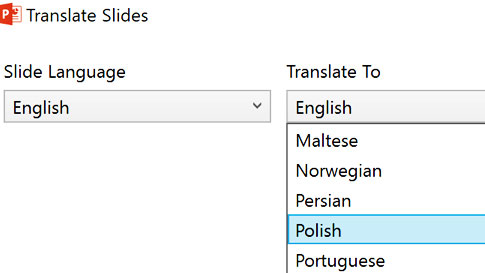
Translated presentations with preserved formatting
The "Translate Slides" button allows presenters to translate their whole presentation while preserving its formatting.
How Presentation Translator works
The technologies behind presentation translator.
Presentation Translator for PowerPoint is powered by the Microsoft Translator live feature which lets you have translated chats by starting or joining a conversation from the Translator app. Up to 100 people can chat at once using the Translator app or directly from their browser at http://translate.it .
The Microsoft Translator live feature is built using Microsoft Translator core speech translation technology, the Microsoft Translator API, an Azure Cognitive Service.
Presentation Translator integrates the speech recognition customization capabilities of Custom Speech Service (CSS) from Azure’s Cognitive Services to adapt speech recognition to the vocabulary used in the presentation.
How to set-up Presentation Translator for PowerPoint
Learn how to download the add-in, install it, and share the QR and conversation code directly from the presentation so your audience can follow along in their language.
Presentation Translator in Action
For this demo, English is the chosen speech and captioned language - highlighting the use of live captioning for the deaf or hard of hearing community. Users could also join and participate in other languages. The talks were titled "Access and Understanding in the Classroom: How Deaf Children Learn (or not)", given at Microsoft Research on May 9th, 2017.
What is custom speech recognition?
What does custom speech recognition do.
- Improves the accuracy of your subtitles by learning from the content in your slides and slide notes. In some cases, you will see up to 30% improvement in accuracy.
- Customizes speech recognition for industry-specific vocabulary, technical terms, acronyms, and product or place names. Customization will reduce these errors in your subtitles, as long as the words are present in your slide or slide notes.
How to set up custom speech in your presentation
- The first time you customize speech recognition for your presentation, it can take up to 5 minutes for Presentation Translator to finish learning.
- After the first time, the subtitles will start instantaneously unless you update the content of your slides.
- Tip: start the custom speech recognition during a practice run so that you don’t experience delays when you present to your audience.
How does the custom speech recognition feature work?
The custom speech recognition feature works by training unique language models with the content of your slides. The language models behind Microsoft’s speech recognition engine have been optimized for common usage scenarios.
The language model is a probability distribution over sequences of words and helps the system decide among sequences of words that sound similar, based on the likelihood of the word sequences themselves. For example, “recognize speech” and “wreck a nice beach” sound alike but the first sentence is far more likely to occur, and therefore will be assigned a higher score by the language model.
If your presentation uses particular vocabulary items, such as product names or jargon that rarely occur in typical speech, it is likely that you can obtain improved performance by customizing the language model.
For example, if your presentation is about automotive, it might contain terms like “powertrain” or “catalytic converter” or “limited slip differential.” Customizing the language model will enable the system to learn this.
When you use the Customize speech recognition feature in Presentation Translator, your presentation content – including notes from the slides – is securely transmitted to the Microsoft Translator transcription service to create an adapted language model based on this data. Data used for customization is not de-identified and is retained in full, along with the adapted model, by the service for thirty (30) days from last use to support your future presentations and use of the language modeling.
Tips for using Presentation Translator
Audio/visual set-up.
Before you get started, you’ll need:
- A working microphone: We suggest using a Bluetooth headset so you can move around without restrictions. Check out our list of recommended headsets
- PowerPoint for Windows: PC only. Make sure you do not have any Office applications open while Presentation Translator installs. Once installed, the add-in will update automatically each time a new version is published.
- Permissions: If you are an educator and use a school login for PowerPoint, you may need to contact your administrator to install the add-in on your device(s).
- Internet connection: A hard-wired connection is ideal, but a reliable WiFi connection works well also.If you’re using the add-in for an event, the lecturer should use a wired connection if possible, or dedicated WiFi. Although it will work on WiFi or 4G, if either is weak, or there’s a lot of competition for bandwidth, it can adversely affect performance. Audience participants can use WiFi or 4G as they are only receiving transcriptions or translations and their data requirements are much lower.
How to set up customized content
Depending on what you’re presenting you will probably want to customize how Presentation Translator “understands” your content.
Here are a few tips to set-up CSS:
- Include all relevant content: Don’t forget your presenter notes! Before CSS “learns” your content, the content needs to be present within the slides or slide notes. Full sentences will be used for word contexts, so a full script of your presentation within the slide notes will be useful.
- After you click “Start Subtitling”, a dialogue box will appear to set-up your presentation. Make sure to check the box that says “Personalize speech recognition” so it can customize your presentation speech model*. This will take 3 to 5 minutes depending on the length of your presentation.
- Train in advance. Content, notes, and audio logs will be retained by the service for thirty (30) days from last use to support future presentations. You only need to train the system again if you have updated content or it’s past 30 days since the last training.
* Currently only English and Chinese are supported.
Microsoft Translator live feature
Now that your audio, visual, and presentation content are ready to go, you can now start presenting! This is where audience participation can play a role – to expand the audience that understands your content, or invite them to comment in real-time in their own language.
Here are a few tips to set-up the Microsoft Translator live feature:
- After you click “Start Subtitling”, a dialogue box will appear to set-up your presentation. Under “Additional Settings”, make sure to check the box that says “Add instructional slide”. This will explain to the audience how they can view subtitles on their own devices.
- The add-in will then insert the instructional slide before the start of your presentation. These instructions will allow your audience to easily join the conversation (up to 100 people) on their device, in their language.
- You can choose to “unmute” the audience – allow comments directly from their device – or “mute” the audience so your presentation is uninterrupted. You can simply click “Audience Unmuted” towards the end of the presentation for an interactive Q&A session.
More resources

Presentation Translator Help & FAQs
Get your questions answered by searching our Help and FAQ section.
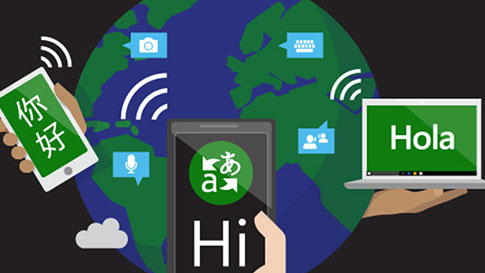
Translator languages
Want to know what features are supported for your chosen language? Visit our languages page.

Translator for business
Learn more about how Microsoft Translator’s text and speech translation technology can globalize your business and connect with your customers worldwide.
Download the app
To start using Presentation Translator for PowerPoint, download both the PowerPoint add-in and the Translator app for an interactive experience.
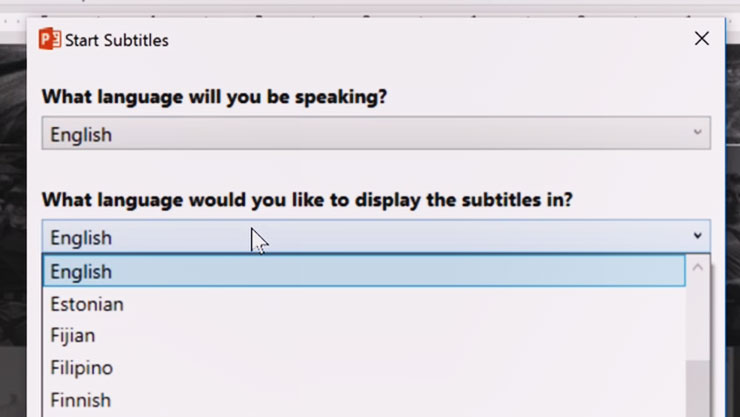
Download the add-in (Windows only).
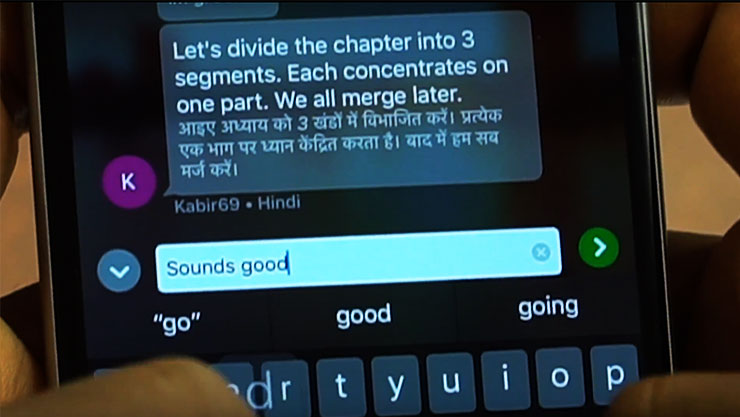
Translator app
Students can follow along with Presentation Translator in their own language and language learners can have one-on-one translated conversations with teachers using the app.

Purdue Online Writing Lab Purdue OWL® College of Liberal Arts
Writing for a Chinese Business Audience

Welcome to the Purdue OWL
This page is brought to you by the OWL at Purdue University. When printing this page, you must include the entire legal notice.
Copyright ©1995-2018 by The Writing Lab & The OWL at Purdue and Purdue University. All rights reserved. This material may not be published, reproduced, broadcast, rewritten, or redistributed without permission. Use of this site constitutes acceptance of our terms and conditions of fair use.
While many of the genres and conventions of business writing in English are found everywhere, some are unique to particular contexts, and may prove challenging to those attempting to do business in those contexts. Being able to create appropriate formal and informal written business documents in these contexts not only contributes to a more efficient business enterprise, but also enables the writer to be seen as knowledgeable and culturally sensitive.
This handout is designed to provide basic information on writing effectively in English for business audiences in the People's Republic of China. While the information in the handout is designed from the perspective of familiarity with the norms of North American business writing , it will also be helpful as a guide for anyone who is unfamiliar with business writing in China, including students from China. The information included below is meant to serve as a quick and ready reference sheet on Chinese business writing. Information borrowed directly from other writers are marked with one or more asterisks (*) and are listed at the end of the page.
The topics discussed in this handout are:
Letters and Memos
- Style considerations
Two important notes must be made:
- This handout is designed only for business writing in mainland China, not for writing based in Hong Kong or in Taiwan (the Republic of China).
- Since English is a foreign language in Chinese contexts, and not an adopted second language as it is in India, the standards for letters and memos below will not always apply. If you are writing from an organization in an Anglophone (English-speaking) country, the standards of business writing in Anglophone countries may be expected. Conversely, if you are writing within a Chinese context-as a member of a Chinese company, for example-the Chinese norms may apply. In either case, if you are writing to a Chinese audience, apply the information on style and social consdierations below to the standard that you choose. Check with colleagues for the standard practices of your company.
The purposes of business letters and memos in China parallel the purposes they serve in North American businesses: introducing a candidate for employment, requesting information, making complaints, disseminating information to an office, proposing projects, making sales, and so on.
- Make sure that your letterhead includes a fax number. If it doesn't, type it directly beneath the letterhead. Faxing continues to be an important component of doing business in China.
- If a letter is generated on organizational letterhead, enter a document number on the far right side of the page, below the letterhead. This number identifies the letter's place in the organization's history of letters, as well as other information. North American use of reference numbers is not as common as it is in Chinese companies.
- Beneath the document number but on the left side of the page, type only the name of the addressee's organization (not the address), followed by the name and appropriate title of the individual addressee. Chinese names are traditionally written with the surname (family name) first, followed by the given name. If your addressee has already written it with the given name first, though, continue to follow that form.
- Write a salutation ("Dear ______:") as you would in a North American letter, then body of the letter, with an introductory paragraph, body paragraph(s), and a closing paragraph.
- The sender name and date are typed toward the right side of the page, without a complimentary close. Dates are typed immediately under the sender name, in year-month-day format without commas (ex: 2007-05-16), rather than in the month-day-year North American format (May 16, 2007). Use of numbers instead of month names is a more regular occurrence.
- As with a North American letter, type "CC" for anyone receiving an additional copy of the letter, followed by their names. A list of enclosures is optional.
YOUR ORGANIZATIONAL LETTERHEAD
New Millennium Electronics
Ms. Chang Biyu
Dear Ms. Chang:
I am writing to provide more information on the sales presentation taking place on Friday, June 15.
The merchandise samples, brochures, and presentation slides have all been prepared, and our sales team is in the process of tailoring their presentation to the particular needs of your company. I have enclosed a copy of the brochure and photographs of the merchandise samples for you to inspect. Right now, we believe the presentation will take about one hour. If you would like more or less time, we are very flexible and would be happy to accommodate you.
Please do not hesitate to e-mail ([email protected]) if you have any questions. I am looking forward to meeting you in person on the fifteenth.
- Memos are printed on organizational letterhead, and in many cases, all contact information (address, e-mail address, telephone, and fax number) is included. If any of these are missing, type them on the bottom after your name, not on the top.
- Memorandum numbers, comparable to the letter reference numbers noted above are included near the top of the page, underneath organizational letterhead, on the left side of the page. Enter the date immediately below the memorandum number.
- Below the date and in the center of the page, type the subject (you don't need to say “subject” or “re”), and below that, type "From" and your name. Unlike North American memos, there is no explicit mention of the recipient's name.
- Type the body of the memo.
- Type your name again along the left side of the page. Include contact information if it is not included in the letterhead.
Memorandum #60320
June 15 Sales Presentation Preparations
Photographs of the merchandise to be displayed during the June 15 sales presentation will be circulated over the next week, along with copies of the sales brochure. Please enter your comments on both in the feedback form below this memo, and send them to me by 5:00 p.m. on Monday, May 21.
As is the case in nearly every country, Chinese businesses use A4 paper (210 × 297 mm/8.27 × 11.7 inches), rather than the 8 ½ × 11 inch (215.9 × 279.44 mm) letter and 8 ½ × 14 inch (216 × 356 mm) legal sizes that are standard in the United States and Canada. You will also find B5 paper (6.9 × 9.8 inches, 176 × 250 mm) in use on occasion, although not nearly as often as A4. Format your documents accordingly, by changing the paper size used by Microsoft Word (click File, then Page Setup; click the Paper tab, choose the paper size from the pull down menu, then click OK). You can also format PDF files, by clicking File, then Page Setup, and choosing A4 from the Size pull down menu before clicking OK—but this is not something you will be forced to do, since Adobe Reader and Adobe Acrobat both re-size pages to automatically fit the user’s paper size. Web pages and other electronic documents that are not meant for print follow universal display standards, and do not need to be formatted differently.
For domestic mail in China, it is important to use only 260 mm × 185 mm (10.24 × 7.28 inch) envelopes. Domestic mail sent in envelopes that do not correspond to this size will be returned.
Style Considerations
For the most part, the norms of North American business writing are valued in Chinese business writing. There are, however, some subtle but important variations in discourse that your writing should reflect, enabling you to better connect with your audiences.
“Cold calling” as it is understood in North America happens far less often in Chinese contexts.* This does not mean that strangers do not communicate with one another to open talks for business, of course. It does mean that a writer will refer to any commonalities they share with their addressee. This can be a reference to a common acquaintance:
My long-time colleague, Mr. Li Jianguo, has often mentioned the quality of your company’s electronics repairs.
It can also take the form of an assumed awareness of the addressee’s particular circumstances (an important strategy in sales letters):
Your firm is growing, so of course you would be interested in finding out how to access new overseas markets.
Official communications, letters and other written communications that are not primarily personal, come under the general heading of the term “gongwen.” Within gongwen, there are three kinds of relationships: superior to subordinate (“xiaxing”), equal to equal (“pingxing”), and subordinate to superior (“shangxing”). What constitutes “xiaxing” (ex., a memo announcing layoffs) and “shangxing” (ex., a human resources report to a supervisor) is usually obvious across cultures, but “pingxing” encompasses most sales writing, as well as official letters. In each case, remain conscious of the language that you use to convey deference, respectful leadership, or equality of status.**
Use titles and family names in all your business correspondence. Do not use given names by themselves.
Notes and References
* Boraks, David. “Chinese Business Culture: Doing Business in the Chinese-Speaking World.” 31 May 2007. http://chinese-school.netfirms.com/doingbusiness.html
**Zhu, Yunxia. “Business Writing in Mainland China: A Look at the Development of Sales Genres.” Intercultural Communication, 3. 2000. 31 May 2007. http://www.immi.se/intercultural/nr3/zhu.htm
- Skip to primary navigation
- Skip to main content
- Skip to primary sidebar
- Skip to footer
StoryLearning
Learn A Language Through Stories
How to Write in Chinese – A Beginner’s Guide
You probably think learning how to write in Chinese is impossible.
And I get it.
I’m a native English speaker, and I know how complex Chinese characters seem.
But you’re about to learn that it's not impossible .
I’ve teamed up with Kyle Balmer from Sensible Chinese to show you how you can learn the basic building blocks of the Chinese written language, and build your Chinese vocabulary quickly.
First, you’ll learn the basics of how the Chinese written language is constructed. Then, you’ll get a step-by-step guide for how to write Chinese characters sensibly and systematically .
Wondering how it can be so easy?
Then let’s get into it.
Don't have time to read this now? Click here to download a free PDF of the article
By the way, if you want to learn Chinese fast and have fun, my top recommendation is Chinese Uncovered which teaches you through StoryLearning®.
With Chinese Uncovered you’ll use my unique StoryLearning® method to learn Chinese through story… not rules.
It’s as fun as it is effective.
If you’re ready to get started, click here for a 7-day FREE trial.
How To Write In Chinese
Chinese is a complex language with many dialects and varieties.
Before we dive into learning to write Chinese characters, let’s just take a second to be clear exactly what we’ll be talking about.
First, you’ll be learning about Mandarin Chinese , the “standard” dialect. There are 5 main groups of dialects and perhaps 200 individual dialects in China & Taiwan. Mandarin Chinese is the “standard” used in Beijing and spoken or understood, by 2/3 of the population.
Second, there are two types of Chinese characters: Traditional and Simplified . In this article, we’ll be talking about Simplified Chinese characters, which are used in the majority of Mainland China.
There is an ongoing politicised debate about the two kinds of characters, and those asking themselves: “Should I learn traditional or simplified Chinese characters?” can face a difficult choice.
- For more on difference between Simplified and Traditional characters read this article
- To learn more about “the debate” read this excellent Wikipedia article
- If you want to switch Simplified characters into Traditional, you might like the fantastic New Tong Wen Tang browser plugin
First Steps in Learning Chinese Characters
When learning a European language, you have certain reference points that give you a head start.
If you're learning French and see the word l'hotel , for example, you can take a pretty good guess what it means! You have a shared alphabet and shared word roots to fall back on.
In Chinese this is not the case.
When you're just starting out, every sound, character, and word seems new and unique. Learning to read Chinese characters can feel like learning a whole set of completely illogical, unconnected “squiggles”!
The most commonly-taught method for learning to read and write these “squiggles” is rote learning .
Just write them again and again and practise until they stick in your brain and your hand remembers how to write them! This is an outdated approach, much like reciting multiplication tables until they “stick”.
I learnt this way.
Most Chinese learners learnt this way.
It's painful…and sadly discourages a lot of learners.
However, there is a better way.
Even without any common reference points between Chinese and English, the secret is to use the basic building blocks of Chinese, and use those building blocks as reference points from which to grow your knowledge of written Chinese.
This article will:
- Outline the different levels of structure inherent in Chinese characters
- Show you how to build your own reference points from scratch
- Demonstrate how to build up gradually without feeling overwhelmed
The Structure Of Written Chinese
The basic structure of written Chinese is as follows:
I like to think of Chinese like Lego . .. it's very “square”!
The individual bricks are the components (a.k.a radicals ).
We start to snap these components together to get something larger – the characters.
We can then snap characters together in order to make Chinese words.
Here's the really cool part about Chinese: Each of these pieces, at every level, has meaning.
The component, the character, the word… they all have meaning.
This is different to a European language, where the “pieces” used to make up words are letters.
Letters by themselves don't normally have meaning and when we start to clip letters together we are shaping a sound rather than connecting little pieces of meaning. This is a powerful difference that comes into play later when we are learning vocabulary.
Let's look at the diagram again.
Here we start with the component 子. This has the meaning of “child/infant”.
The character 好 (“good”) is the next level. Look on the right of the character and you'll see 子. We would say that 子 is a component of 好.
Now look at the full word 你好 (“Hello”). Notice that the 子 is still there.
- The character 好 is built of the components 女 and 子.
- The character 你 is built from 人 + 尔.
- The word 你好 in turn is constructed out of 你 + 好.
Here's the complete breakdown of that word in an easy-to-read diagram:
Now look at this photo of this in real life !
Don't worry if you can't understand it. Just look for some shapes that you have seen before.
The font is a little funky, so here are the typed characters: 好孩子
What components have you seen before?
Did you spot them?
This is a big deal.
Here's why…
Why Character Components Are So Important
One of the big “scare stories” around Chinese is that there are 50,000 characters to learn.
Now, this is true. But learning them isn't half as bad as you think.
Firstly, only a few thousand characters are in general everyday use so that number is a lot more manageable.
Second, and more importantly, those 50,000 characters are all made up of the same 214 components .
And you already know one of them: 子 (it's one of those 214 components).
The fact that you can now recognise the 子 in the image above is a huge step forward.
You can already recognise one of the 214 pieces all characters are made up of.
Even better is the fact that of these 214 components it's only the 50-100 most common you'll be running into again and again.
This makes Chinese characters a lot less scary.
Once you get a handle on these basic components, you'll quickly recognise all the smaller pieces and your eyes will stop glazing over!
This doesn't mean you'll necessarily know the meaning or how to pronounce the words yet (we'll get onto this shortly) but suddenly Chinese doesn't seem quite so alien any more.
Memorising The Components Of Chinese Characters
Memorising the pieces is not as important as simply realising that ALL of Chinese is constructed from these 214 pieces.
When I realised this, Chinese became a lot more manageable and I hope I've saved you some heartache by revealing this early in your learning process!
Here are some useful online resources for learning the components of Chinese characters:
- An extensive article about the 214 components of Chinese characters with a free printable PDF poster.
- Downloadable posters of all the components, characters and words.
- If you like flashcards, there's a great Anki deck here and a Memrise course here .
- Wikipedia also has a sweet sortable list here .
TAKEAWAY : Every single Chinese character is composed of just 214 “pieces”. Only 50-100 of these are commonly used. Learn these pieces first to learn how to write in Chinese quickly.
Moving From Components To Chinese Characters
Once you've got a grasp of the basic building blocks of Chinese it's time to start building some characters!
We used the character 好 (“good”) in the above example. 好 is a character composed of the components 女 (“woman”) and 子 (“child”).
Unlike the letters of the alphabet in English, these components have meaning .
(They also have pronunciation, but for the sake of simplicity we'll leave that aside for now!)
- 女 means “woman” and 子 means “child”.
- When they are put together, 女 and 子 become 好 …and the meaning is “good”.
- Therefore “woman” + “child” = “good” in Chinese 🙂
When learning how to write in Chinese characters you can take advantage of the fact that components have their own meanings.
In this case, it is relatively easy to make a mnemonic (memory aid) that links the idea of a woman with her baby as “good”.
Because Chinese is so structured, these kind of mnemonics are an incredibly powerful tool for memorisation.
Some characters, including 好, can also be easily represented graphically. ShaoLan's book Chineasy does a fantastic job of this.
Here's the image of 好 for instance – you can see the mother and child.
Visual graphics like these can really help in learning Chinese characters.
Unfortunately, only around 5% of the characters in Chinese are directly “visual” in this way. These characters tend to get the most attention because they look great when illustrated.
However, as you move beyond the concrete in the more abstract it becomes harder and harder to visually represent ideas.
Thankfully, the ancient Chinese had an ingenious solution, a solution that actually makes the language a lot more logical and simple than merely adding endless visual pictures.
Watch Me Write Chinese Characters
In the video below, which is part of a series on learning to write in Chinese , I talk about the process of actually writing out the characters. Not thousands of times like Chinese schoolchildren. But just as a way to reinforce my learning and attack learning Chinese characters from different angles.
My Chinese handwriting leaves a lot to be desired. But it's more about a process of reinforcing my language learning via muscle memory than perfecting my handwriting.
You'll also hear me discuss some related issues such as stroke order and typing in Chinese.
The Pronunciation Of Chinese Characters
The solution was the incredibly unsexy sounding… (wait for it…) “phono-semantic compound character”.
It's an awful name, so I'm going to call them “sound-meaning characters” for now!
This concept is the key to unlocking 95% of the Chinese characters.
A sound-meaning character has a component that tells us two things:
- the meaning
- a clue to how the character is pronounced
So, in simple terms:
95% of Chinese characters have a clue to the meaning of the character AND its pronunciation.
到 means “to arrive”.
This character is made of two components. On the left is 至 and on the right is 刀.
These are two of the 214 components that make up all characters. 至 means “to arrive” and 刀 means “knife”.
Any idea which one gives us the meaning? Yup – it's 至, “to arrive”! (That was an easy one 🙂 )
But how about the 刀? This is where it gets interesting.
到 is pronounced dào.
刀, “knife” is pronounced dāo.
The reason the 刀 is placed next to 至 in the character 到 is just to tell us how to pronounce the character! How cool is that?
Now, did you notice the little lines above the words: dào and dāo?
Those are the tone markers, and in this case they are both slightly different. These two characters have different tones so they are not exactly the same pronunciation.
However, the sound-meaning compound has got us 90% of the way to being able to pronounce the character, all because some awesome ancient Chinese scribe thought there should be a shortcut to help us remember the pronunciation!
Let's look at a few more examples of how 刀 is used in different words to give you an idea of the pronunciation.
Even if sometimes:
- the sound-meaning character gives us the exact sound and meaning
- or it gets us in the ballpark
- or worse it is way off because the character has changed over the last 5,000 years!
Nevertheless, there's a clue about the pronunciation in 95% of all Chinese characters, which is a huge help for learning how to speak Chinese.
TAKEAWAY : Look at the component parts as a way to unlock the meaning and pronunciations of 95% of Chinese characters. In terms of “hacking” the language, this is the key to learning how to write in Chinese quickly.
From Chinese Characters To Chinese Words
First we went from components to characters.
Next, we are going from characters to words.
Although there are a lot of one-character words in Chinese, they tend to either be classically-rooted words like “king” and “horse” or grammatical particles and pronouns.
The vast majority of Chinese words contain two characters.
The step from characters to words is where, dare I say it, Chinese script gets easy!
Come on, you didn't think it would always be hard did you? 🙂
Unlike European languages Chinese's difficulty is very front-loaded.
When you first learn to write Chinese, you'll discover a foreign pronunciation system, a foreign tonal system and a very foreign writing system.
As an English speaker, you can normally have a good shot at pronouncing and reading words in other European languages, thanks to the shared alphabet.
Chinese, on the other hand, sucker-punches you on day one… but gets a little more gentle as you go along.
One you've realised these things:
- there aren't that many components to deal with
- all characters are made up of these basic components
- words are actually characters bolted together
…then it's a matter of just memorising a whole bunch of stuff!
That's not to say there isn't a lot of work involved, only to say that it's not particularly difficult. Time-consuming, yes. Difficult, no.
This is quite different from European languages, which start off easy, but quickly escalate in difficulty as you encounter complicated grammar, tenses, case endings, technical vocabulary and so on.
Making words from Chinese characters you already know is easy and really fun . This is where you get to start snapping the lego blocks together and build that Pirate Island!
The Logic Of Chinese Writing
Here are some wonderful examples of the simplicity and logic of Chinese using the character 车 which roughly translates as “vehicle”.
- Water + Vehicle = Waterwheel = 水 +车
- Wind + Vehicle = Windmill = 风+车
- Electric + Vehicle = Tram/Trolley = 电+车
- Fire + Vehicle = Train = 火+车
- Gas + Vehicle = Car = 汽+车
- Horse + Vehicle = Horse and cart/Trap and Pony = 马+车
- Up + Vehicle = Get into/onto a vehicle =上+车
- Down + Vehicle = Get out/off a vehicle =下+车
- Vehicle + Warehouse = Garage = 车+库
- To Stop + Vehicle = to park = 停+车
Chinese is extremely logical and consistent.
This is a set of building blocks that has evolved over 5,000 years in a relatively linear progression. And you can't exactly say the same about the English language!
Just think of the English words for the Chinese equivalences above:
Train, windmill, millwheel/waterwheel, tram/trolley, car/automobile, horse and cart/trap and pony.
Unlike Chinese where these concepts are all linked by 车 there's very little consistency in our vehicle/wheel related vocabulary, and no way to link these sets of related concepts via the word itself.
English is a diverse and rich language, but that comes with its drawbacks – a case-by-case spelling system that drives learners mad.
Chinese, on the other hand, is precise and logical, once you get over the initial “alienness”.
Making The Complex Simple
This logical way of constructing vocabulary is not limited to everyday words like “car” and “train”. It extends throughout the language.
To take an extreme example let's look at Jurassic Park .
The other day I watched Jurassic Park with my Chinese girlfriend. (OK, re -watched. It's a classic!)
Part of the fun for me (annoyance for her) was asking her the Chinese for various dinosaur species.
Take a second to look through these examples. You'll love the simplicity!
- T Rex 暴龙 = tyrant + dragon
- Tricerotops 三角恐龙 three + horn + dinosaur
- Diplodocus 梁龙 roof-beam + dragon
- Velociraptor 伶盗龙 clever + thief + dragon (or swift stealer dragon)
- Stegosaurus 剑龙 (double-edged) sword + dragon
- Dilophosaurus 双脊龙 double+spined+dragon
Don't try to memorise these characters, just appreciate the underlying logic of how the complex concepts are constructed .
(Unless, of course, you are a palaeontologist…or as the Chinese would say a Ancient + Life + Animal + Scientist!).
I couldn't spell half of these dinosaur names in English for this article. But once I knew how the construction of the Chinese word, typing in the right characters was simple.
Once you know a handful of characters, you can start to put together complete words, and knowing how to write in Chinese suddenly becomes a lot easier.
In a lot of cases you can take educated guesses at concepts and get them right by combining known characters into unknown words.
For more on this, check my series of Chinese character images that I publish on this page . They focus on Chinese words constructed from common characters, and help you understand more of the “building block” logic of Chinese.
TAKEAWAY : Chinese words are constructed extremely logically from the underlying characters. This means that once you've learned a handful of characters vocabulary acquisition speeds up exponentially.
How To Learn Written Chinese Fast
Before diving into learning characters, make sure you have a decent grounding in Chinese pronunciation via the pinyin system.
The reason for this is that taking on pronunciation, tones and characters from day one is really tough.
Don't get me wrong, you can do it. Especially if you're highly motivated. But for most people there's a better way.
Learn a bit of spoken Chinese first.
With some spoken language under your belt, and an understanding of pronunciation and tones, starting to learn how to write in Chinese will seem a whole lot easier.
When you're ready, here's how to use all the information from this article and deal with written Chinese in a sensible way.
I've got a systematic approach to written Chinese which you can find in detail on Sensible Chinese .
Right now, I'm going to get you started with the basics.
The Sensible Character System
The four stages for learning Chinese characters are:
Sounds technical huh? Don't worry, it's not really.
This part of the process is about choosing what you put into your character learning system.
If you're working on the wrong material then you're wasting your efforts. Instead choose to learn Chinese characters that you are like to want to use in the future.
My list in order of priority contains:
- daily life: characters/words I've encountered through daily life
- textbooks: characters/words I've learnt from textbooks
- frequency lists: characters/words I've found in frequency lists of the most common characters and words
2. Processing
This is the “learning” part of the system.
You take a new word or character and break it down into its component parts. You can then use these components to create memory aids.
Hanzicraft.com or Pleco's built-in character decomposition tool are fantastic for breaking down new characters. These will be helpful until you learn to recognise the character components by sight. These tools will also show you if there are sound-meaning component clues in the character.
Use the individual components of a character to build a “story” around the character. Personal, sexy and violent stories tend to stick in the mind best! 🙂 I also like to add colours into my stories to represent the tones (1st tone Green, 2nd tone Blue etc.)
After the “input” and the “process”… it's time to review it all!
The simplest review system is paper flashcards which you periodically use to refresh your memory.
A more efficient method can be found in software or apps that use a Spaced Repetition System, like Anki or Pleco .
An important point: Review is not learning .
It's tempting to rely on software like Anki to drill in the vocabulary through brute-force repetition. But don't skip the first two parts – processing the character and creating a mnemonic are key parts of the process.
It isn't enough to just learn and review your words… you also need to put them into use !
Thankfully, technology has made this easier than ever. Finding a language exchange partner or a lesson with a cost-effective teacher is super simple nowadays, so there's no excuse for not putting your new vocabulary into action!
The resources I personally use are:
- Spoken – iTalki
- Written – Lang-8
- Short form written – WeChat / HelloTalk
Importantly, whilst you are using your current vocabulary in these forms of communication, you'll be picking up new content all the time, which you can add back into your system.
The four steps above are a cycle that you will continue to rotate through – all the corrections and new words you receive during usage should become material to add to the system.
To recap, the four steps of systematically learning Chinese characters are:
By building these steps into your regular study schedule you can steadily work through the thousands of Chinese characters and words you'll need to achieve literacy.
This is a long-haul process! So having a basic system in place is very important for consistency.
You can find out a lot more about The Sensible Chinese Character Learning System and how to write in Chinese here .
Top Chinese Learning Links And Resources
- Chinese Language Learning Resource List – a curated list of tools and content available online and in print to help your Chinese learning, all categorised by usage type.
- Sensible Character Learning System – the full system outlined in a series of blog articles for those who want more detail and tips on how to refine their character learning.
- 111 Mandarin Chinese resources you wish you knew – Olly’s huge list of the best resources on the web for learning Chinese
I hope you enjoyed this epic guide to learning how to write in Chinese!
Please share this post with any friends who are learning Chinese, then leave us a comment below!
Language Courses
- Language Blog
- Testimonials
- Meet Our Team
- Media & Press
Steal My Method?
I’ve written some simple emails explaining the techniques I’ve used to learn 8 languages…
Which language are you learning?
What is your current level in
Where shall I send them?
We will protect your data in accordance with our data policy.
Perfect! You’ve now got access to my most effective tips…
Download Your Free StoryLearning® Kit!
Discover the world famous story-based method that 1,023,037 people have used to learn a language quickly…
What is your current level in
WAIT! Don't skip this next step…
Welcome aboard!
You're about to discover the StoryLearning secrets thousands of my students have used to master Arabic!
But first, we need to make sure my emails arrive safely!
It will take less than 30 seconds. Here's what you need to do:
1) Go to your inbox & look for the email I just sent (Gmail users click here)
2) Mark the email as “important” & add me to your contact list
3) Send me a quick reply and say hi!
I'll see you on the other side
4) Start learning Spanish through story now with a FREE 7-day trial of Spanish Uncovered
What is your current level in [language]?
Perfect! You’ve now got access to my most effective [level] [language] tips…
Where shall I send them?
Download this article as a FREE PDF ?
What is your current level in Latin?
Perfect! You’ve now got access to my most effective [level] Latin tips…
Where shall I send the tips and your PDF?
What is your current level in Norwegian?
Perfect! You’ve now got access to my most effective [level] Norwegian tips…
What is your current level in Swedish?
Perfect! You’ve now got access to my most effective [level] Swedish tips…
What is your current level in Danish?
Perfect! You’ve now got access to my most effective [level] Danish tips…
NOT INTERESTED?
What can we do better? If I could make something to help you right now, w hat would it be?
What is your current level in [language] ?
Perfect! You’ve now got access to my most effective [level] [language] tips, PLUS your free StoryLearning Kit…

Download this article as a FREE PDF?
Great! Where shall I send my best online teaching tips and your PDF?
Download this article as a FREE PDF ?
What is your current level in Arabic?
Perfect! You’ve now got access to my most effective [level] Arabic tips…
FREE StoryLearning Kit!
Join my email newsletter and get FREE access to your StoryLearning Kit — discover how to learn languages through the power of story!
Download a FREE Story in Japanese!
Enter your email address below to get a FREE short story in Japanese and start learning Japanese quickly and naturally with my StoryLearning® method!
What is your current level in Japanese?
Perfect! You’ve now got access to the Japanese StoryLearning® Pack …
Where shall I send your download link?
Download Your FREE Natural Japanese Grammar Pack
Enter your email address below to get free access to my Natural Japanese Grammar Pack and learn to internalise Japanese grammar quickly and naturally through stories.
Perfect! You’ve now got access to the Natural Japanese Grammar Pack …
What is your current level in Portuguese?
Perfect! You’ve now got access to the Natural Portuguese Grammar Pack …
What is your current level in German?
Perfect! You’ve now got access to the Natural German Grammar Pack …
Train as an Online Language Teacher and Earn from Home
The next cohort of my Certificate of Online Language Teaching will open soon. Join the waiting list, and we’ll notify you as soon as enrolment is open!
Perfect! You’ve now got access to my most effective [level] Portuguese tips…
What is your current level in Turkish?
Perfect! You’ve now got access to my most effective [level] Turkish tips…
What is your current level in French?
Perfect! You’ve now got access to the French Vocab Power Pack …
What is your current level in Italian?
Perfect! You’ve now got access to the Italian Vocab Power Pack …
Perfect! You’ve now got access to the German Vocab Power Pack …
Perfect! You’ve now got access to the Japanese Vocab Power Pack …
Download Your FREE Japanese Vocab Power Pack
Enter your email address below to get free access to my Japanese Vocab Power Pack and learn essential Japanese words and phrases quickly and naturally. (ALL levels!)
Download Your FREE German Vocab Power Pack
Enter your email address below to get free access to my German Vocab Power Pack and learn essential German words and phrases quickly and naturally. (ALL levels!)
Download Your FREE Italian Vocab Power Pack
Enter your email address below to get free access to my Italian Vocab Power Pack and learn essential Italian words and phrases quickly and naturally. (ALL levels!)
Download Your FREE French Vocab Power Pack
Enter your email address below to get free access to my French Vocab Power Pack and learn essential French words and phrases quickly and naturally. (ALL levels!)
Perfect! You’ve now got access to the Portuguese StoryLearning® Pack …
What is your current level in Russian?
Perfect! You’ve now got access to the Natural Russian Grammar Pack …
Perfect! You’ve now got access to the Russian StoryLearning® Pack …
Perfect! You’ve now got access to the Italian StoryLearning® Pack …
Perfect! You’ve now got access to the Natural Italian Grammar Pack …
Perfect! You’ve now got access to the French StoryLearning® Pack …
Perfect! You’ve now got access to the Natural French Grammar Pack …
What is your current level in Spanish?
Perfect! You’ve now got access to the Spanish Vocab Power Pack …
Perfect! You’ve now got access to the Natural Spanish Grammar Pack …
Perfect! You’ve now got access to the Spanish StoryLearning® Pack …
Where shall I send them?
What is your current level in Korean?
Perfect! You’ve now got access to my most effective [level] Korean tips…
Perfect! You’ve now got access to my most effective [level] Russian tips…
Perfect! You’ve now got access to my most effective [level] Japanese tips…
What is your current level in Chinese?
Perfect! You’ve now got access to my most effective [level] Chinese tips…
Perfect! You’ve now got access to my most effective [level] Spanish tips…
Perfect! You’ve now got access to my most effective [level] Italian tips…
Perfect! You’ve now got access to my most effective [level] French tips…
Perfect! You’ve now got access to my most effective [level] German tips…
Download Your FREE Natural Portuguese Grammar Pack
Enter your email address below to get free access to my Natural Portuguese Grammar Pack and learn to internalise Portuguese grammar quickly and naturally through stories.
Download Your FREE Natural Russian Grammar Pack
Enter your email address below to get free access to my Natural Russian Grammar Pack and learn to internalise Russian grammar quickly and naturally through stories.
Download Your FREE Natural German Grammar Pack
Enter your email address below to get free access to my Natural German Grammar Pack and learn to internalise German grammar quickly and naturally through stories.
Download Your FREE Natural French Grammar Pack
Enter your email address below to get free access to my Natural French Grammar Pack and learn to internalise French grammar quickly and naturally through stories.
Download Your FREE Natural Italian Grammar Pack
Enter your email address below to get free access to my Natural Italian Grammar Pack and learn to internalise Italian grammar quickly and naturally through stories.
Download a FREE Story in Portuguese!
Enter your email address below to get a FREE short story in Brazilian Portuguese and start learning Portuguese quickly and naturally with my StoryLearning® method!
Download a FREE Story in Russian!
Enter your email address below to get a FREE short story in Russian and start learning Russian quickly and naturally with my StoryLearning® method!
Download a FREE Story in German!
Enter your email address below to get a FREE short story in German and start learning German quickly and naturally with my StoryLearning® method!
Perfect! You’ve now got access to the German StoryLearning® Pack …
Download a FREE Story in Italian!
Enter your email address below to get a FREE short story in Italian and start learning Italian quickly and naturally with my StoryLearning® method!
Download a FREE Story in French!
Enter your email address below to get a FREE short story in French and start learning French quickly and naturally with my StoryLearning® method!
Download a FREE Story in Spanish!
Enter your email address below to get a FREE short story in Spanish and start learning Spanish quickly and naturally with my StoryLearning® method!
FREE Download:
The rules of language learning.
Enter your email address below to get free access to my Rules of Language Learning and discover 25 “rules” to learn a new language quickly and naturally through stories.
What can we do better ? If I could make something to help you right now, w hat would it be?
Perfect! You’ve now got access to my most effective [level] [language] tips…
Download Your FREE Spanish Vocab Power Pack
Enter your email address below to get free access to my Spanish Vocab Power Pack and learn essential Spanish words and phrases quickly and naturally. (ALL levels!)
Download Your FREE Natural Spanish Grammar Pack
Enter your email address below to get free access to my Natural Spanish Grammar Pack and learn to internalise Spanish grammar quickly and naturally through stories.
Free Step-By-Step Guide:
How to generate a full-time income from home with your English… even with ZERO previous teaching experience.
What is your current level in Thai?
Perfect! You’ve now got access to my most effective [level] Thai tips…
What is your current level in Cantonese?
Perfect! You’ve now got access to my most effective [level] Cantonese tips…
I want to be skipped!
I’m the lead capture, man!
Join 84,574 other language learners getting StoryLearning tips by email…
“After I started to use your ideas, I learn better, for longer, with more passion. Thanks for the life-change!” – Dallas Nesbit
Perfect! You’ve now got access to my most effective [level] [language] tips…
Find The Perfect Language Course For You!
Looking for world-class training material to help you make a breakthrough in your language learning?
Click ‘start now’ and complete this short survey to find the perfect course for you!
Do you like the idea of learning through story?
Do you want…?
- About WordPress
- Get Involved
- WordPress.org
- Documentation
- Learn WordPress

- Classes and Materials
- Course Description and Procedures
- Weekly Syllabi
- Instructors
Introduction to Chinese Language
Chinese, the Han language, is the predominant language in China spoken by more than 93% of the population . The Chinese language roughly comprises ten main dialects : Northern Mandarin, Southwestern Mandarin, Eastern Mandarin, Xiang, Gan, Kejia, Wu, Northern Min, Southern Min, and Yue (Cantonese). Generally speaking, the writing system is identical in all dialects; however, the grammatical structures vary slightly, and the pronunciations and the number of tones differ greatly from dialect to dialect. Although the various dialects are still in use and people often retain their native dialects while living in another region, the Chinese government has been promoting a unified, standard language, which is called, “pu tong hua” (commonly language) in mainland China or “guo yu” (national language), based on the pronunciation of the Beijing dialect. Why privilege Beijing dialect?
- Historically, Beijing (Peking) has been the national capital for over one millennium from Liao, through the Jin, Yuan, Ming up to Qing dynasties. As Beijing has been the national center for political, commercial and academic activities, its dialect has become widely used and accepted as the official language for communication among state officials from different regions.
- The Beijing dialect is intelligible over a greater area than all the other dialects, spoken by 70% of the population from northeastern provinces.
- Many Chinese classical novels were written in either the Beijing dialect or in dialects linguistically close to the Beijing dialect, and the popularity of these novels contributed to the increasing use of this northern dialect.
- The Beijing dialect consists of clear and simple sounds ; it has 21 initial sounds and 36 final sounds, and four tones (as opposed to, say, Cantonese that has nine tones).
Characteristics of the Chinese Language
Firstly, Chinese is a tonal language. Tone is a significant pitch: when the pitch of a syllable changes, its meaning also changes. For example, the Mandarin language uses four tones: high level [1], high rising [2], falling rising [3] and high falling [4]. These four tones are represented by tone marks placed on the main vowel of a syllable.
The meaning of a syllable may change if and when the tone changes. For example, tāng 汤 = soup, táng 糖 = sugar, tǎng 躺 = lie down, and tàng 烫 = hot; or mā 妈 = mother, má 麻 = hemp, mǎ 马 = horse, and mà 骂 = scold.
Secondly, there is a tendency toward monosyllabism in Chinese. A syllable in Chinese consists of three parts: tone, initial, and final. Initial is a consonant sound while final is a vowel. Almost every single syllable has its own meaning: mín(2) 民 = people; zhǔ(3) 主 = master, but together they form a disyllabic compound word meaning “democracy”. Other disyllabic morphemes: luó-bo 萝卜 = turnip; pú-tao 葡萄 = grapes; pí-pā 琵琶 = loquat; xī-shuài 蟋蟀 = cricket. in these cases the disyllabic morphemes carry no meaning if they are separated into single syllables.
Thirdly, there is a lack of inflection in the indication of number, tense, case, and gender. For example, with regard to number: one book (yi ben shu, 一本书), two books (liang ben shu, 两本书) or three books (san ben shu, 三本书). With regard to time: “I love her” and “I loved her” can both be stated as “wo ai ta” (我爱她). No need to conjugate verbs. With regard to case: “I love her” = 我爱她; and “she loves me” (她爱我). With regard to gender: “He loves me” and “She loves me” are both stated as “ta ai wo.” (他爱我)
- Initials and finals ; there are 23 consonants (initials) and 35 vowels (finals) in Mandarin Chinese. The same cannot be said about regional dialects, with differences significant that they are almost like a foreign language (when they say: 1, 2, 3, 4, 5, 6, 7, 8, 9, 10. See this: I love you).
- Search for:
- October 2013

How to write in Chinese – a Beginner’s Guide

How to write in Chinese
- 1.1.1.1 The following table shows the 6 most fundamental strokes in Chinese writing.
- 1.1.1.2 Stroke Name
- 1.1.1.3 Stroke
How to write in Chinese – A Beginner’s Guide in Chinese Writing
Learning Chinese can be a bit scary and seems impossible at the first glance . They just seem like scary blocks of words if you don’t know the idea of how they were formed.You will have no idea where to start.
Chinese characters are built on radicals which are similar to alphabets in English. However, unlike English alphabets, each radical has its own meaning.The radicals are combined into characters and the characters combined into words. If you think the radicals are the most basic part of the Chinese writing, you are wrong.
Before you start learning Chinese writing, you need to know how to write them first. Strokes are the classified set of line patterns that are arranged and combined to form Chinese characters.Once you’ve mastered the strokes and learned the logic behind the radicals, learning Chinese writing will become a lot easier.
In this blog, I’m going to teach you the most basic of Chinese writing – strokes, and explain some of the logic behind the common radicals.
How many characters are there in Chinese Writing?
Before we start, let me give you an overview of the amount Chinese characters in Chinese writing. There are over 50,000 Chinese characters . Don’t worry you don’t need to know them all. Even an educated Chinese person know around 8000 characters. The highest level of HSK requires you to know 2600 characters only. You will be able to read about 98% of everyday written Chinese with this amount. And it will even be more comforting if you know the fact that you will be able to read 70% of the Chinese writing once you learn the 250 most used Chinese Characters.
As if how you should motivate yourself to learn Chinese, you can read in our previous blog: I want to learn Chinese .
Understanding strokes and strokes orders in Chinese writing
By now you probably know the importance of radicals in Chinese writing. But Chinese writing is not as simple as typing on the keyboard “ How to type Chinese Characters on the keyboard “. You will be able to type if you know the pinyin and the characters.
But for writing on the paper is another thing. Just knowing the pinyin is not enough . You need to know the strokes to know how these radicals are constructed. That’s not all, you also need to know the correct stroke order and the direction to be able to write each character correctly.
Besides, many educated Chinese people take pride in their ability to write the Chinese characters in the right order. If they see you can write in the right order, they will be impressed and treat you as a real educated person.
Among a lot of strokes, there are only 13 basic strokes that you need to know. Once you get a hold on these 13 strokes, the rest are just the combinations of these 13. After you have learned the strokes and the strokes orders, you will know how to write a character in correct stroke order no matter how complex the character is .
The following table shows the 6 most fundamental strokes in Chinese writing.
| 提 |
The second table shows the 5 strokes with the hook
These 11 strokes are the most basic strokes in Chinese writing. The rest of the strokes are just the combinations of the above ones.Now that you have learned all the basic strokes, let’s move on to which stroke and in which order you need to write. The picture below shows you the 8 rules that you need to follow in Chinese writing.
You can read more about the stroke: Chinese Stroke
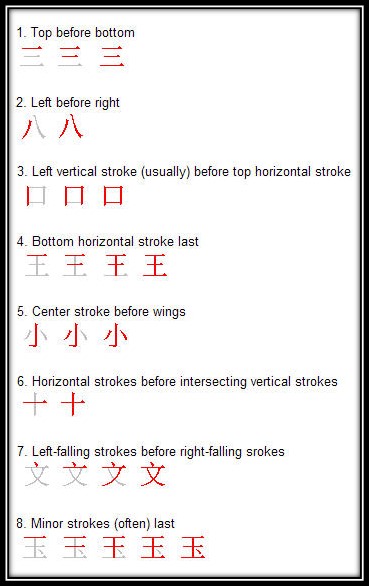
After you’ve learned all of the strokes and stroke order rules, you will now be able to write any character even if you don’t know what they mean!
Understanding Chinese radicals
Let’s move on to the Chinese radicals! The radicals can be considered as the pillar of the Chinese language learning . Each radical has its own meaning.
- “心” is a Character which represents the “heart”.
- When it acts as a radical, “心 ” can usually be seen together with the “heart-related” characters .
- Some of the examples are “想 – xiǎng (think),怒 – nù (angry),感 – gǎn (feel, sense)” which are all somewhat related to emotion, feeling, mind, thinking or thought.
- If 心 radical is written below the character ,it is called 心字底 (xīn zi dǐ, meaning 心 at the bottom)。
- If it is written on the left side , it is usually written as “忄” and we call it 竖心旁 (shù xīn páng). e.g.: 快-kuài (quick),慢- màn (slow),情- qíng (feelings, emotions).
- Some radicals are also used for their phonetic sounds.
- 青 qīng radical can be seen in a lot of Chinese characters which sound ” qīng “ . They are called phonetical radical because the words with 青 radical are pronounced in similar phonetic sound with only tonal difference .
- 请 – qǐng (to ask, to request ), 情 – qíng (feelings, emotions), 清 – qīng (clear, distinct ).
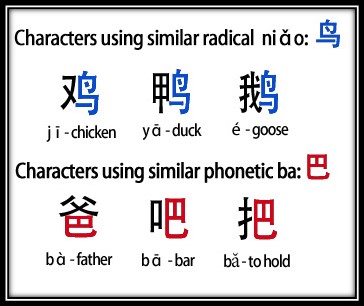
Chinese characters with similar radicals
Another interesting fact about Chinese writing is that the Chinese characters are written as pictures in the past like the Egyptians! Those characters derived from images are called “pictogram”. Many of the easy Chinese characters are pictograms! Then they slowly transformed into the systematic words we are using today.
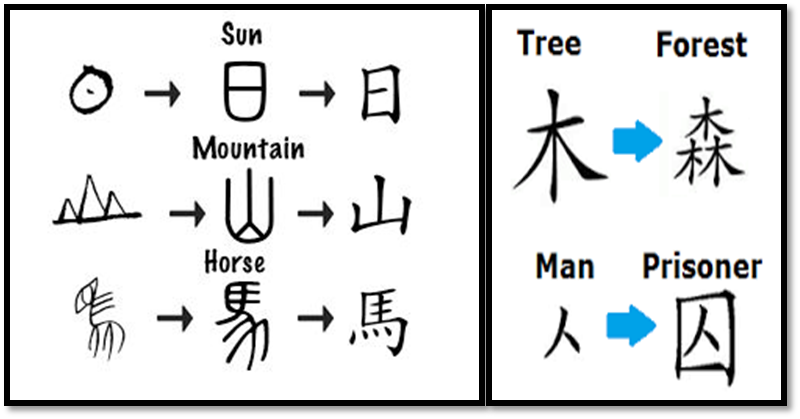
Transformation of Chinese characters
If you want to explore more simple characters, check out: 40 easy Chinese Characters
Connection between the strokes and the radicals
After you’ve learned about the strokes and the radicals, some of you might still be confused about ” how are these 2 related” ? So I’m going to explain it to you by using the example of “火 – huǒ” (fire) radical .
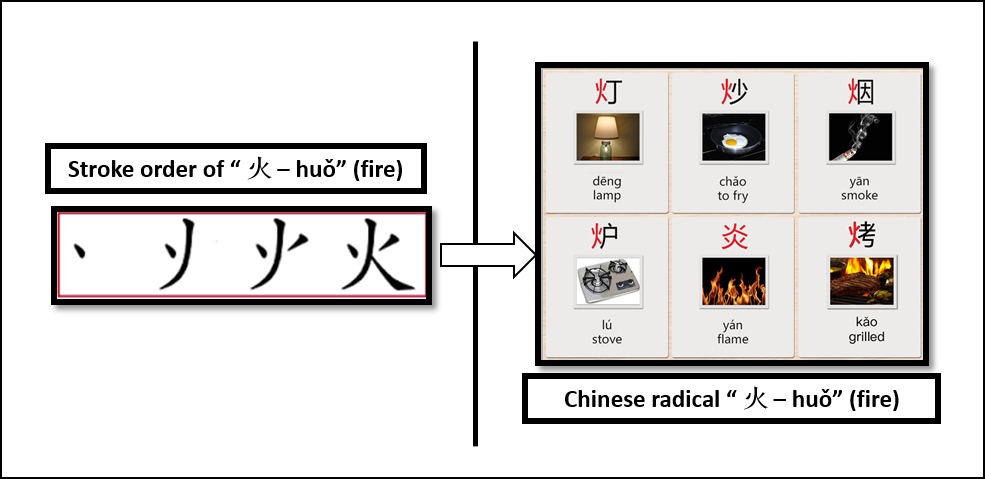
the connection between the stroke and the radical
As you can see in the picture above, “火 – huǒ” (fire) radical has 4 strokes . “火 – huǒ” ( fire ) radical is usually found together with the characters related to ‘fire’. E.g., ” 灯 – dēng” (lamp), “炒 – ” (fry ), “烟 – yān” (smoke), ” 炎 – yàn” (flame), ” 炉 – lú” (stove) and “烤 – kǎo” (roast), all of which have something to do with fire. But as I’ve mentioned earlier, sometimes radical represents the phonetic sound of the character instead of the meaning.
So in short, “the strokes let us know how to write” whereas ” the radicals give us the meaning behind each character for us to memorize more easily” .
Summary of Chinese writing
In conclusion, I would like to summarize what we have learned earlier.
- In Chinese writing, you need to learn the strokes and strokes orders first .
- Only then, you will know how to write Chinese characters in the correct way.
- After that, you also need to study the radicals and the logic behind them.
- You can also make good use of pictograms image to help you remember the characters easily.
That way, you won’t need to do rote learning ( writing the characters again and again until you remember them) for Chinese characters. I hope this blog motivates you to start Chinese writing right now!
Knowledge is good but the act of presentation is better. Why not start a free trial and start to learn mandarin today! For more learn Chinese materials, please stay tuned with us!
Related posts:

Leave a Reply Cancel reply
Your email address will not be published. Required fields are marked *
Save my name, email, and website in this browser for the next time I comment.
This site uses Akismet to reduce spam. Learn how your comment data is processed .
Level Basic: Beginner Chinese Course
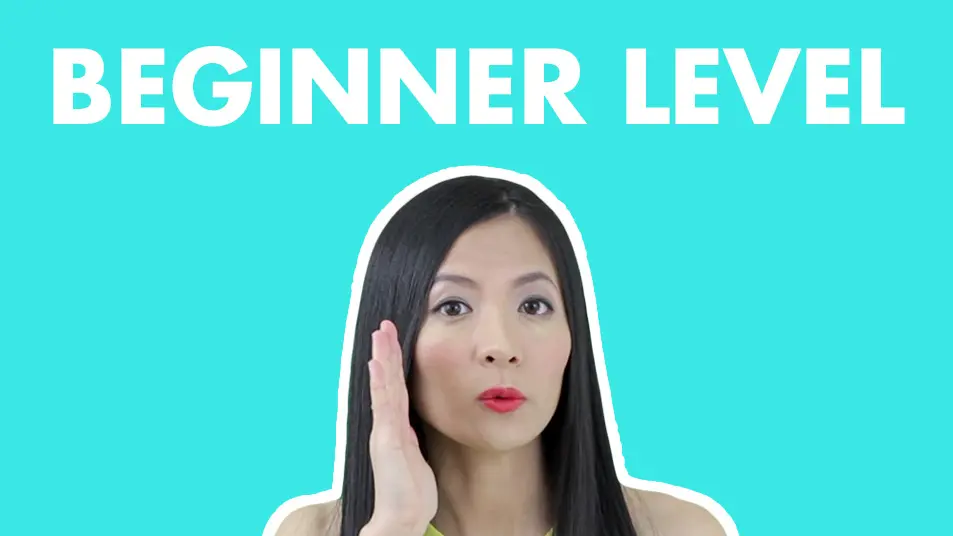
Beginner Level Chinese
| the best course for beginner chinese.
| Lili Hao, Course Writer & Teacher |
What You Can Do After Learning this Course

Nicola's Review of ChineseFor.Us
About This Course
"Get started with the premier beginner Chinese course from ChineseFor.Us and learn Chinese for day 1 beginners. Our course is the perfect way to get your foot in the door and master the basics of the language. With over 200 useful Chinese sentences, 38 Chinese grammar points, 120 Chinese characters, and 43 Chinese radicals, you'll have everything you need to start your Chinese learning adventure off on the right foot. Each lesson is presented in a video format that you can stream from most devices, and comes with an audio vocabulary book, written grammar explanations, and interactive quizzes. Whether you're looking for easy Chinese lessons for beginners, basic Chinese language learning, or want to master Mandarin Chinese for beginners, our course has got you covered. Start your journey to learn this beautiful and exciting language today with ChineseFor.Us."
Useful Chinese Sentences
Chinese grammar points, chinese characters, chinese radicals.
Show Me All Lessons

Course Writer & Teacher
Lili Hao is the dedicated Teacher and Course Writer at ChineseFor.Us. With a Master's Degree in Chinese Linguistics and a Bachelor's Degree in English, Lili brings a wealth of knowledge and experience to her teaching. Having taught Chinese as a second language at several universities in China, including Sichuan University, Lili has honed her skills and teaching methodologies over the past 10 years. As a certified HSK and YCT Examiner, Lili understands the importance of standardized Chinese language proficiency tests and incorporates this knowledge into her course material. Her passion for teaching and helping students achieve their language goals shines through in every lesson she creates.
Course Structure
- There are 4 units in total.
- In every unit, there are 5 lessons.
- Each lesson has 2 topics. Topic 1 focuses on speaking and topic 2 focuses on characters.
- One quiz per topic.
- One dialogue and one long story per unit.
- Two assigned presentation tasks per unit.
Learn How To Write Chinese Characters
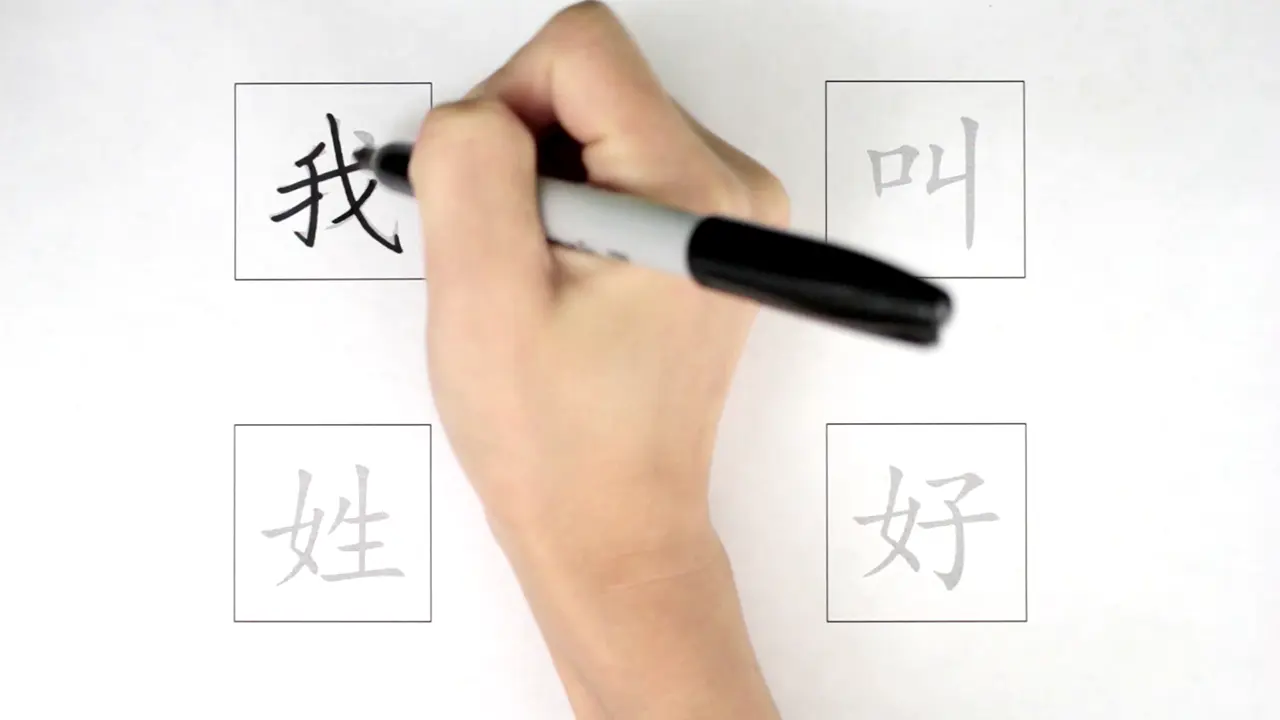
This course will also teach you how to write Chinese characters, each topic 2 lets you follow along with our video and practice writing on a downloadable writing sheet. As a beginner Chinese learner we believe learning characters and how to write characters is crucial to the Chinese learning process. Start learning today and you will be impressing your friends and family in no time.
What do I get from this Beginner Chinese Course?
- sentence drills to master structures
- short dialogues for instant practice
- interactions with a real teacher
- pausing time for you to speak out loud
- knowledge of character construction and word formation
- clickable audio vocabulary book with translation and HSK notes
- grammar guide with English translation
- example sentences with Characters, Pinyin and English
- practicing vocabulary and sentences
- skill development from Pinyin to Characters
- typing, sorting, listening, recognizing questions
- a dialogue or a story that put language into real usage
- language skills of longer speeches
- assigned writing and speaking presentation practice for each lesson
- community to post and share your practice work
Absolutely not!
All the Beginner Chinese Lessons are solely developed by the ChineseFor.Us team.
Our website is your virtual Chinese classroom.
Learn our beginner course here and you don’t have to get extra books or any other materials.
This is and Level 1 are the only HSK 1 Course you need to learn HSK Level 1 and pass the test.
This course combined with our Level 1 Course covers all the required grammar points and vocabulary for HSK 1.
It's for so much more than just passing the test!
Our priority is real language skills. We designed the course so that the students will be able to speak, understand and read Chinese no problem.
And we made sure that all HSK 1 requirements are also covered while achieving practical language skills.
Take free trial lessons now!
All lessons of this course have been released. Check out other courses .
Pinyin | Tones | Characters Previous Level
Next Level Level 1 (HSK 1+)
Course Content
48 thoughts on “level basic: beginner chinese course”.
Dear Lili, thank you so much for this beginner course. This was extremely helpful on my way to learn the basics of Chinese. I look forward to HSK ! course with you. Kamila
Dear Nesika/Kamila, We’re so glad you enjoy the course! Good luck with your studies! We look forward to your progress!
Hi teacher, i wanted to know if the Chinese we learn is same like in Taiwan?
Thank you for your interest. Speaking wise, people from both Mainland China and Taiwan speaks Chinese, in Mainland China the Simplified Characters are used, while in Taiwan the Traditional Characters are used. We have a lesson explaining the differences between Simplified Characters and Traditional Characters .
这个给大家想知道如果方法是不是真的。明天是我学中文一年的纪念日。我可以读,写,还说跟斗中文母语的人了。我希望这个短信会帮助每位人在猜测是否者会把你帮助来到说普通话。真的会!谢谢,加油! This is for everyone that wants to know if this method works or not. Tomorrow will be my learning Chinese 1 year anniversary. I can read, write, and speak Mandarin with native speakers now. I hope this message will help every person that is guessing if this will help you learn Chinese. It really will! Thank you, and Keep Going!
wow, I am Impressed, I am in my early weeks.
I found this website some time ago and I think it’s the best video-course based website. But I have one doubt, I understand that every level will enable me to apply for the HSK test, and that’s great, I wanna know if this course is gonna teach me SLANG as well, aside from all the formalities given in this course.
Thanks for your interest. Our goal is to release structured courses as our priority, as there are many other ways to study slang. Also, slang isn’t standard across regions in China, and is subject to change every couple of years.
We thank you for your high rating of courses and we wish you the best of luck with your studies.
Terrific! I’m buying my premium subscription very soon then. BTW, I’m looking forward to HSK 4 and more!
This so helpful. Thank you so much
Hi, I am a beginner. I just finished the basic skills courses. Should I do this Beginner Chinese Course before the HSK1?
Yes we recommend starting from our Beginner Chinese Course. Also we have a Learning Road Map for reference.
Hi Teacher! Am 9 and I already know Chinese! All thanks to you! Thanks teacher ;>
I Look Forward to Learning Throughout These Courses
hello, first of all I would like to congratulate you for the courses. They are really useful and you can learn a lot. Looking at my course, although I am not completely sure, I think I have completed the quizzes and the videos. I would like to know what else do I have to do to finish this elementary level. I apologize for my questions, 谢谢!
Please see “CERTIFICATE” section on our FAQ page for guide to check for incomplete steps and learning progress. Here’s a quick link https://chinesefor.us/frequently-asked-questions/#CERTIFICATE
Hi Can you please suggest how to improve listening skills ? I am finding it very difficult to make out the meaning of the conversation in Mandarin for reading comprehension. Cannot seem to get the native speaking style and the fast pace. Thanks
Practice makes perfect.
That is why our structured courses are designed with a lot of practice materials to help develop and improve all language skills: listening, speaking, reading, writing and even translating. If you follow each step without skip and practice strictly under the course instructions, improvements can be expected to be seen.
Also at beginner level, we wouldn’t worry if a student has trouble “getting the native speaking style”. Instead, at beginner level, we recommend students to focus on the course content: grammatical structures and sentence patterns, vocabulary and character writing.
And achieving “native level” can be held as a long-term goal. It takes time and effort, but eventually you can get there.
Really glad I got to read this informative and reassuring response. Long term goal. Focusing on what matters at the moment as you’ve mentioned.
Hi! Is it common to focus only in Speaking and listening… and once you are ok with it… maybe start with writing and reading? In case I want to do that, if I dont do the writing lessons, is ok to follow the course? Or to do it properly I must do all one by one?
We highly recommend learning the characters (at least to be able to read and type them) from Day 1. The reasons are explained in the four introduction lessons in our Character Course .
你好 Lili 老师,I took Chinese one and two in college last semester, we learned all the way up to how to order food in a restaurant and how to tell time. Should I continue in the beginners’ course or should I move onto HSK1?
Please refer to “Which course should I start with?” on our FAQ page, under “COURSE” section.
Ni Hao Lili, xièxiè for everything (sorry if it’s wrong i haven’t watched ALL of your videos yet). But still thank you
Hi Lili, can I have a link for downloading writing sheets? Thank you for everything.
Is this content ok for kids to learn as beginners
Thanks for your interest. The course is not designed specifically for kids, but kids can learn it. Preferably kids older than 3rd Grade.
Great, I’ve recommended this to my older sister because my niece and nephew take Chinese in school but struggle with pronunciation at the moment. They’re in Grade 1 and kindergarten but I think if my older sister takes these courses with her husband then they can definitely help their children do better in Chinese language.
Thank you for your help. Before, I had no clue to speak Chinese. But, through this course, I could speak in Chinese a little. I want to speak Chinese fluently. Thank you.
NI HAO lili
Hi Lili, thank you so much for your hard work. I’m learning a lot!!
so far this is the best website I have seen. thanks, Lili
Thank you for making a very thoughtful and comprehensive course. I really appreciate all the details that has been thought in the course. I can’t wait to start learning HSK 1 course.
Hello LiLi, how can I buy this course?
You can unlock all lessons and features by getting a premium membership here→
So, I have a question about names. When I look at translation of my name to Chinese it looks sort of like this 黑暗山强度 . My name is Sierra, and that was it’s meaning if I go based on why my parents named me…. but it seems impossible to use that name. It’s a Spanish Irish translation into Chinese, and someone I’m trying to practice with said it is much easier if I try to adopt a Chinese name for the future.
We have a video lesson on How to Get A Chinese Name , check it out if you’re interested!
Excellent course, I found it very useful! The only area of opportunity that I found was that the final exam was way too easy and too short, it should be longer and harder so we can really test everything that you taught us. Other than that, I loved it.
I understand that some learners might expect this Final Test to be more challenging. When I made this test, it was more for the purpose of testing whether the learner has mastered all the vocabulary and grammar in this level (also for learners to test if they need to study this course if they have been learning Chinese with other resources and decide to use our course), instead of challenging them to see if they will be capable for more complicated language tasks. Especially because this is a beginner course. The test is 10 questions per quiz, but you can retake it and the whole question bank has 250 questions. But the quizzes for Level 2 Course are much more challenging, because learners are expected to be able to use the language in a more flexible way in that level.
Hi lili, ummm…. I’m currently learning chinese mandarin, i’m asking for a favor?!?! Can you give me a tip to pass an chinese oral reading?? It’s so hard for me, because it all written in chinese characters, hope you can help me!!!
Hi Lili, I took this course last year (probably some lessons this year too). I did all the tests but I don’t have a ‘certificate’ for any test? I do have a green checkmark next to all the tests. Is there a separate test I have to pass? Thanks, Valentin
Hi Valentin, At the moment we don’t currently have “Certificates” set up for the courses. But it’s definitely something we plan to implement in the future. But congratulations on completing all the quizzes. Keep up the good work!
Just an update, now we have included a certificate for each course. A “Certificate of Completion” will be generated in PDF form after you completing a course. Please see “CERTIFICATE” section on our FAQ page for details.
I like that your Beginner Chinese Course is simple and to the point whereas others are too complicated for beginners.
Thank you! I’m glad you enjoyed our Beginner Chinese Course.
Leave a Reply Cancel reply
You must be logged in to post a comment.
Username or Email Address
Remember Me
Registration confirmation will be emailed to you.
Basic Greetings and Self-Introduction in Chinese
Greetings and self-introductions are the cornerstone of effective communication in any language. In Mandarin Chinese, understanding how to greet someone and introduce yourself can open doors to meaningful interactions and cultural connections. In this post, we’ll explore the fundamental basics of greetings and self-introduction in Chinese, equipping you with the essential phrases to start conversations confidently.
Table of Contents
**1. Greetings:**
**你好!(Nǐ hǎo!) – Hello!** A versatile greeting suitable for all situations.
**早上好!(Zǎo shàng hǎo!) – Good morning!** Used in the morning until around 11 AM.
**下午好!(Xià wǔ hǎo!) – Good afternoon!** Appropriate for the afternoon hours.
**晚上好!(Wǎn shàng hǎo!) – Good evening!** Used in the evening from around 6 PM.
**再见!(Zàijiàn!) – Goodbye!** A common way to say farewell.
**2. Self-Introduction:**
**我叫[Your Name]。(Wǒ jiào [Your Name].) – My name is [Your Name].** A simple and direct way to introduce yourself.
**我是[Your Nationality]人。(Wǒ shì [Your Nationality] rén.) – I am [Your Nationality].** Mention your nationality to foster cultural exchange.
**我来自[Your Country/Place]。(Wǒ láizì [Your Country/Place].) – I come from [Your Country/Place].** Share where you’re from to initiate conversations.
**很高兴认识你!(Hěn gāoxìng rènshí nǐ!) – Nice to meet you!** Express your pleasure in making someone’s acquaintance.
**3. Polite Phrases:**
**请问,你好吗?(Qǐngwèn, nǐ hǎo ma?) – Excuse me, how are you?** A polite way to inquire about someone’s well-being.
**不好意思,我能问一下,这是什么?(Bù hǎoyìsi, wǒ néng wèn yíxià, zhè shì shénme?) – Excuse me, can I ask what this is?** Useful when seeking information or clarifications.
**4. Cultural Tip:**
Remember, addressing people using their titles (先生 – xiānshēng for Mr. and 女士 – nǚshì for Mrs./Ms.) adds a respectful touch to your interactions.
Mastering basic greetings and self-introductions is a crucial step toward effective communication in Mandarin Chinese. These phrases provide you with a strong foundation to initiate conversations, show respect, and foster connections with native speakers. By using these phrases with sincerity, you’ll not only bridge the language gap but also demonstrate your genuine interest in the Chinese language and culture. Happy learning!
Don’t miss out on expanding your knowledge – visit our Chinese learning resource page !
Immerse yourself in an unforgettable learning experience! – Book a Trial Chinese Learning Class Learn Chinese Online
Related Posts

Chinese Vocabulary
Terms about Love in Chinese

Fruit Names in Chinese

80 Loan Words (Borrowed Words) in Mandarin Chinese

- Manage Email Subscriptions
- How to Post to DZone
- Article Submission Guidelines
- Manage My Drafts
2024 DZone Community Survey: Tell us what's in your tech stack. Help us build a better DZone. Enter for a chance to win swag!
Automate (almost) Anything: Join us for a discussion to learn how to build and maintain automations, integrating databases, APIs, and more!
Database Systems: In 2024, the focus around databases is on their ability to scale and perform in modern data architectures. See why.
Data Pipeline Essentials: Dive into the fundamentals of data pipelines and the problems they solve for modern enterprises.
- What Are SOC and SIEM? How Are They Connected?
- Five Steps To Building a Tier 1 Service That Is Resilient to Outages
- A Robust Distributed Payment Network With Enchanted Audit Functionality - Part 1: Concepts
- Top 5 Incidents and Outages of 2021
- Leveraging Snowflake’s AI/ML Capabilities for Anomaly Detection
- Content Detection Technologies in Data Loss Prevention (DLP) Products
- A Hands-On Guide to OpenTelemetry: Better Tracing With Automatic Instrumentation
- Data Fusion: Enhancing Interoperability, Privacy, and Security
- Data Engineering
How to do a presentation in China? Some of my experiences
Join the DZone community and get the full member experience.
So the culture is different from Western culture we all know that! I am certainly not an expert on China but after living in China for almost 2 years knowing some language and working in a chinese company seeing presentations every week and also visiting over 30 western and chinese companies placed in China I think I have some insights about how you should organize your presentation in China.
Since I recently went to Shanghai in order to to research exchange with Jiaotong University I was about to give a presentation to introduce my institute and me. So here you can find my rather uncommon presentation and some remarks, why some slides where designed in the way they are.
http://www.rene-pickhardt.de/wp-content/uploads/2012/11/ApexLabIntroductionOfWeST.pdf
Guanxi – your relations
First of all I think it is really important to understand that in China everything is related to your relations ( http://en.wikipedia.org/wiki/Guanxi ). A chinese business card will always name a view of your best and strongest contacts. This is more important than your adress for example. If a conference starts people exchange namecards before they sit down and discuss. This principle of Guanxi is also reflected in the style presentations are made. Here are some basic rules:
- Show pictures of people you worked together with
- Show pictures of groups while you organized events
- Show pictures of the panels that run events
- Show your partners (for business not only clients but also people you are buying from or working together with in general)
My way of respecting these principles:
- I first showed a group picture of our institute!
- I also showed for almost every project where I could get hold of it pictures of the people that are responsible for the project
- I did not only show the European research projects our university is in but listed all the different partners and showed logos of them
The second thing is that in China the concept of family is very important. I would say as a rule of thumb if you want to make business with someone in china and you havent been introduced to their family things are not going like you might expect this. For this reason I have included some slides with a worldmap going further down to the place where I was born and where I studied and where my parents still leave!
When I choosed a worldmap I did not only take one with Chinese language but I also took one where china was centered. In my contact data I also put chinese social networks. Remember Twitter, Facebook and many other sites are blocked in China. So if you really want to communicate with chinese people why not getting a QQ number or weibo account?
Design of the slides
You saw this on conferences many times. Chinese people just put a hack a lot of stuff on a slide. I strongly believe this is due to the fact that reading and recognizing Chinese characters is much faster than western characters. So if your presentation is in Chinese Language don’t be afraid to stuff your slides with information. I have seen many talks by Chinese people that where literally reading word by word what was written on the slides. Where in western countries this is considered bad practice in China this is all right.
Speaking of Language: Of course if you know some chinese it shows respect if you at least try to include some chinese. I split my presentation in 2 parts. One which was in chinese and one that was in english.
Have an interesting take away message
So in my case I included the fact that we have PhD positions open and scholarships. That our institut is really international and the working language is english. Of course I also included some slides about my past and current research like Graphity and Typology
During the presentation:
In China it is not rude at all if ones cellphone rings and one has more important stuff to do. You as presenter should switch of your phone but you should not be disturbed or annoyed if people in the audience receive phone calls and go out of the room doing that business. This is very common in China.
I am sure there are many more rules on how to hold a presentation in China and maybe I even made some mistakes in my presentation but at least I have the feeling that the reaction was quite positiv. So if you have questions, suggestions and feedback feel free to drop a line I am more than happy to discuss cultural topics!
Published at DZone with permission of René Pickhardt , DZone MVB . See the original article here.
Opinions expressed by DZone contributors are their own.
Partner Resources
- About DZone
- Send feedback
- Community research
- Advertise with DZone
CONTRIBUTE ON DZONE
- Become a Contributor
- Core Program
- Visit the Writers' Zone
- Terms of Service
- Privacy Policy
- 3343 Perimeter Hill Drive
- Nashville, TN 37211
- [email protected]
Let's be friends:
Get the Reddit app
This is a community for people studying or teaching Chinese - or even if you're just interested in Chinese languages. Discussion of all Chinese languages/dialects is welcome! Please post interesting links, language learning advice, or questions!
What to write at the end of presentation in chinese ? Like in English we write "Thank you" or "The end". What do we write in Chinese ?🖇️🖇️🖇️🖇️🖇️🙄
By continuing, you agree to our User Agreement and acknowledge that you understand the Privacy Policy .
Enter the 6-digit code from your authenticator app
You’ve set up two-factor authentication for this account.
Enter a 6-digit backup code
Create your username and password.
Reddit is anonymous, so your username is what you’ll go by here. Choose wisely—because once you get a name, you can’t change it.
Reset your password
Enter your email address or username and we’ll send you a link to reset your password
Check your inbox
An email with a link to reset your password was sent to the email address associated with your account
Choose a Reddit account to continue
- Cambridge Dictionary +Plus
Translation of presentation – English–Traditional Chinese dictionary
Your browser doesn't support HTML5 audio
presentation noun ( EVENT )
- The presentation was a collaborative effort by all the children in the class .
- The charity invited the press to a presentation of its plans for the future .
- The magazine asked its readers to send in their comments about the new style of presentation.
- Jenny's retiring and I think there's going to be a small presentation this afternoon .
- Graduates must be in full academic dress at the presentation of certificates .
presentation noun ( APPEARANCE )
(Translation of presentation from the Cambridge English-Chinese (Traditional) Dictionary © Cambridge University Press)
Examples of presentation
Translations of presentation.
Get a quick, free translation!

Word of the Day
compassionate grounds
a reason, especially in law, to allow someone to do something out of sympathy for their suffering

Simply the best! (Ways to describe the best)

Learn more with +Plus
- Recent and Recommended {{#preferredDictionaries}} {{name}} {{/preferredDictionaries}}
- Definitions Clear explanations of natural written and spoken English English Learner’s Dictionary Essential British English Essential American English
- Grammar and thesaurus Usage explanations of natural written and spoken English Grammar Thesaurus
- Pronunciation British and American pronunciations with audio English Pronunciation
- English–Chinese (Simplified) Chinese (Simplified)–English
- English–Chinese (Traditional) Chinese (Traditional)–English
- English–Dutch Dutch–English
- English–French French–English
- English–German German–English
- English–Indonesian Indonesian–English
- English–Italian Italian–English
- English–Japanese Japanese–English
- English–Norwegian Norwegian–English
- English–Polish Polish–English
- English–Portuguese Portuguese–English
- English–Spanish Spanish–English
- English–Swedish Swedish–English
- Dictionary +Plus Word Lists
- presentation (EVENT)
- presentation (APPEARANCE)
- Translations
- All translations
To add presentation to a word list please sign up or log in.
Add presentation to one of your lists below, or create a new one.
{{message}}
Something went wrong.
There was a problem sending your report.
You are using an outdated browser. Please upgrade your browser or activate Google Chrome Frame to improve your experience.
How to Introduce Yourself in Chinese: A Complete Guide
The first step in combining Chinese language and culture involves being prepared to introduce yourself in Chinese at any moment. In a culture based on 关系 ( guānxi – relationships), it’s crucial to be able to describe yourself accurately.
The simplest way to introduce yourself in Chinese is to say 你好 ( nǐ hǎo ) meaning “hello” and 我叫 ( wǒ jiào ) meaning “my name is.”
But, if you want to know even more about the different ways you can introduce yourself and information about you in Chinese, we’re here to help.
Simple Chinese Greetings to Introduce Yourself
Introducing your name in chinese, asking about the other person, reacting to a compliment, share your background to introduce yourself in chinese, talking about: where you’re from, talking about: family, talking about: your education and employment situation, talking about: your income and your children’s grades (yeah, this happens), talking about: hospitality, talking about: what you do for fun, concluding your self-introduction, 12 etiquette tips for chinese conversation, and one more thing....
Download: This blog post is available as a convenient and portable PDF that you can take anywhere. Click here to get a copy. (Download)
The basic Chinese greeting is a well-wish, using the word 好 ( hǎo ) — good. Before saying hǎo , you can insert a time of day or a fitting pronoun. The standard greeting is 你好 ( nǐ hǎo ) — hello, nǐ meaning “you.”
[Personal pronoun] hǎo :
您 ( nín ) — The respectful form of the pronoun “you,” used for addressing elderly people or people with higher social or business status
叔叔 ( shū shu ) — Uncle, used for a man who’s old enough to be your father
阿姨 ( ā yí ) — Aunty, used for a woman could be your mom
爷爷 ( yè ye ) — Literally “father’s father,” used for a man who could be your grandfather
奶奶 ( nǎi nai ) — Literally “father’s mother,” used for a woman who could be your grandmother
[Time of day] hǎo:
早上 ( zǎo shàng ) — Morning (before 8:00 a.m.)
上午 ( shàng wǔ ) — Morning (after 8:00 a.m.)
下午 ( xià wǔ ) — Afternoon
晚上 ( wǎn shàng ) — Evening
In conversation, you’ll likely hear one of two questions asking for your name:
怎么称呼您? ( zěnme chénghū nín? ) — How should I address you?
你叫什么名字? ( nǐ jiào shénme míngzi? ) — What’s your name?
The first question includes the respectful nǐn , meaning it should be used to address older people or people with higher social or business status. In less formal relationships, either question can be used. In both cases, you can respond:
我叫 (wǒ jiào) – My name is, and then say your name
You should use questions and phrases that show you’re taking an interest in the person you’re conversing with, thus… building guānxi . For example , 吃饭了吗? ( chī fàn le ma? ) meaning “have you eaten yet?” is a commonly used phrase that can be used after a typical meal time.
If you already know something about their job or family, do build that relationship by using 怎么样 ( zěnme yàng ) questions:
[Topic of interest] zěnme yàng ? – How’s [topic of interest]?
Topics of interest may include:
生意 ( shēngyì ) — Business, implying the person runs their own business
工作 ( gōngzuò ) — Work as an employee
家人 ( jiārén ) — Family members
父母 ( fùmǔ ) — Parents
孩子 ( háizi ) — Child or children
If you don’t know anything about them and it’s not around a meal time, just jump into the conversation !
At any point after you say your name, your Chinese will likely be complimented. To be polite, they’ll compliment your Chinese regardless of how good it is.
They recognize the challenge of learning a language since most have at least studied English in school, so saying your Chinese is good is a way to elevate you. It’s now your mission to humbly reject such a lofty compliment.
You’ll hear:
你的中文很好! ( nǐ de zhōngwén hěn hǎo! ) — Your Chinese is very good!
You should say:
哪里哪里 ( nǎlǐ nǎlǐ ) — Literally “Where? Where?” implying “I don’t see anyone around here who deserves such a compliment!”
没有 ( méi yǒu ) — Literally “don’t have,” implying you aren’t qualified for such a compliment
Don’t be afraid to admit:
我还在学习中文 ( wǒ hái zài xuéxí zhōngwén ) — I’m still learning Chinese.
我的中文不太好 ( wǒ de zhōngwén bú tài hǎo ) — My Chinese isn’t that great.
If you include a statement about your low Chinese level, it shouldn’t be the focal point of the sentence. For example, instead of “My Chinese isn’t that great,” you could say “Even though my Chinese isn’t that great, I’m happy to tell you a little bit about myself.”
If you can, deflect the compliment to someone else who really deserves it. This shows you know where the credit really goes. For example, after the other person compliments your Chinese, you could say:
让我的老师很高兴 ( ràng wǒ de lǎoshī hěn gāoxìng ) — That would make my teacher very happy.
A good self-introduction in Chinese needs to describe your essence. That all starts with your background: where you’re from, your family, your education, your work situation and even your income. All of this forms a large part of who you are, so this information is important to share with Chinese people.
Because conversations—especially the first one—are all about building guānxi , the heart of the conversation starts immediately after exchanging names.
If someone asks:
你是哪里的? ( nǐ shì nǎlǐ de ?) — Where are you from?
你是哪个国家的? ( nǐ shì nǎge guójiā de? ) — What country are you from?
You can answer:
我是 ___ 的 ( wǒ shì ___ de ) — I’m from ___
我来自 ___ ( wǒ láizì ___) — I’m from ___
If you’re from the local area, you can say:
我是本地的 ( wǒ shì běndì de ) — I’m a local, literally “I’m from this place.”
If you ask them where they’re from (or vice versa) and the answer is a little ambiguous (most Chinese will just say “China”), you can say:
___ 哪里? (___ nǎli ?) — Where in ___?
The purpose of the “where you’re from” questions is really to understand what kind of environment you’re from, so you can use these kinds of words to help them paint a picture of you:
农村 ( nóngcūn ) — Rural area, literally “village”
小城 ( xiǎochéng ) — Small town
城市 ( chéngshì ) — Big city
If you want to explain how an environment may have influenced you even though you aren’t directly from there, you can add the word 附近 ( fùjìn ) — “nearby” after the description of where you’re from (e.g., chéngshì fùjìn – near a big city).
Family is so important in Chinese culture that the language has a specific word for almost every family relationship .
For example, in English we would say “cousin,” but in Chinese it’s “your mom’s older sister’s daughter,” which is completely different from”your mom’s younger sister’s daughter.” Understanding your family relationships will help a Chinese person learn about your values and traits.
Someone may ask you how your parents are doing:
你的父母怎么样? ( nǐ de fùmǔ zěnme yàng? ) — How are your parents?
To say your parents are doing well, you can say:
我的___还好 — ( wǒ de ___ hái hǎo ) — My ___ is/are doing well.
爸爸 ( bàba ) — Dad
妈妈 ( māma ) — Mom
You may also be asked if you have any brothers and sisters:
你有几个兄弟姐妹? ( nǐ yǒu jǐ ge xiōngdì jiěmèi? ) — How many siblings do you have?
To say how many brothers and sisters you have, you can say:
我有 how many 个 relationship . ( wǒ yǒu how many ge relationship) — I have [however many] of [a certain type of relationship.]
哥哥 ( gēge ) — Older brother
弟弟 ( dìdi ) — Younger brother
姐姐 ( jièjie ) — Older sister
妹妹 ( mèimei ) — Younger sister
You will likely be asked if you’re married:
你结婚了吗? ( nǐ jiéhūn le ma? ) — Are you married?
If you’re married, you can say 结婚了 ( jiéhūn le ) — I’m married.
If you’re dating, you can use the sibling sentence structure, minus the “how many” part:
男朋友 ( nán péngyou ) — Boyfriend
女朋友 ( nǚ péngyou ) — Girlfriend
You can use the sibling sentence structure for how many children you have also (if you’re married, you will be asked if you have children):
孩子 ( háizi ) — Child/children
儿子 ( érzi ) — Son
女儿 ( nǚér ) — Daughter
A person’s education and job situation reflect their current social status.
You might be asked:
你做什么工作? ( nǐ zuò shénme gōngzuò? ) — What do you do for work?
是你的专业吗? ( shì nǐ de zhuānyè ma? ) — Is that your profession?
Note : zhuānyè literally means “profession,” but the concept generally implies that it was your major in college, as well.
You could reply:
我是 ___ ( wǒ shì ___) — I’m a ___
我做 ___ ( wǒ zuò ___) — I ___
我上(了)大学 ( wǒ shàng (le) dàxué ) — I attend(ed) a university.
自学的 ( zìxué de ) — I am self-taught.
Similar to your education and job situation, your income and your children’s grades tell about your present situation in caring for yourself and your family, as well as what kind of future you might have. If the conversation gets this far, you will be asked about it.
___ 怎么样? (___ zěnme yàng ?) — How’s ___?
___ 可以吗? (___ kěyǐ ma ?) — Is ___ good enough?
成绩 ( chéngjì ) — Grades
工资 ( gōngzī ) — Income
还可以 ( hái kěyǐ ) — “Not bad.” Like in English, the tone of your voice shows how “not bad” it is.
不错 ( bú cuò ) — Pretty good/hard to complain.
很好 ( hěn hǎo ) — Very good/satisfying.
These conversations typically happen over tea or food. Hospitality is a big part of Chinese culture, so even if it’s their first time meeting you, they’ll probably still invite you to tea or a meal . This shows their willingness to spend time with you and build guānxi .
If you have the time, do accept their offer to have tea or food. This shows your willingness to spend time with them and build guānxi .
They might say something like: 我们喝茶吧 ( wǒmen hē chá ba ) — Let’s have some tea
You should say: 好的 ( hǎo de ) or 可以 ( kěyǐ ) with a smile. Both phrases carry the “that sounds good” meaning, but without the smile, your willingness could be misunderstood as “I guess I have to.”
You should also ask for their phone number or WeChat information . If you have time for tea, ask for this contact info before you leave. If you don’t have time for tea, ask for it so you can make plans to meet again. This shows you view the relationship as worth continuing.
可以给你我的电话号码吗? ( kěyǐ gěi nǐ wǒ de diàn huà hào mǎ ma? ) — Could I give you my phone number?
我们加微信吧 ( wǒmen jiā wēixìn ba ) — Let’s add each other’s WeChat
Grammar note : Saying 吧 ( ba ) is very important. It means you’re suggesting something. If you don’t say “ba,” you’re telling them what to do.
For more formal relationships: 可以加您的微信吗? ( kěyǐ jiā nín de wēixìn ma ?) — Can I add your WeChat?
Grammar note : 吗 ( ma ) is a word that basically adds a question mark to a sentence. For formal relationships, you want to ask permission, not make a suggestion.
Most conversations between Chinese people don’t require the “Where are you from?” part because they take for granted that they’re from China. In those cases, they’ll skip straight from “What’s your name?” to “ What do you like to do? “
你喜欢做什么? ( nǐ xǐhuān zuò shénme? ) — What do you like to do?
我喜欢 ___ ( wǒ xǐhuān ___) — I like to ___
You may be asked how long you’ve had that hobby:
你什么时候开始___? ( nǐ shénme shíhou kāishǐ ___?) — When did you start doing ___?
You could respond:
我 ___ 岁开始 ( wǒ ___ suì kāishǐ ) — I started when I was ___
我从小喜欢 ( wǒ cóng xiǎo xǐhuān ) — I’ve liked it since I was little
我 when 有兴趣了 ( wǒ when yǒuxìngqù le ) — I got interested at a certain time
At this point, it would be natural for you to volunteer why you like doing what you do:
我觉得好玩 ( wǒ juéde hǎo wán ) — I think it’s fun, a phrase you can use to express simple enjoyment
让我 ___ ( ràng wǒ ___) — It makes me feel a certain way, a phrase that expresses contentment
轻松 ( qīngsōng ) — Relaxed
高兴 ( gāoxìng ) – Happy
期待 ( qīdài ) — Also meaning “happy,” but from doing something exciting
给我 ___ ( gěi wǒ ___) — It gives me a certain feeling, a phrase to explain deeper reasons.
安全感 ( ānquángǎn ) — A sense of security
满足感 ( mǎnzúgǎn ) — A sense of satisfaction
成就感 ( chéngjiùgǎn ) — A sense of accomplishment
一点幸福感 ( yīdiǎn xìngfúgǎn ) — A small sense of happiness
Note : xìngfú is viewed as an ultimate goal in life, so if you reach xìngfú through your hobbies, they’ll probably think of you as a very shallow person, or they’ll conclude you have no idea what you’re talking about
At the beginning of the conversation, all you knew was the person’s name. You didn’t know anything else about them. Now, after this conversation, you know something about the person, and they know something about you. This is the time to say things such as:
很高兴认识你 ( hěn gāoxìng rènshi nǐ ) — It was nice to become acquainted with you, literally “I’m happy to have become acquainted with you.”
In a more formal, less developed relationship, you could say:
谢谢您的时间 ( xièxie nín de shíjiān ) — Thank you for your time. This is especially respectful if the meet-and-greet was short, implying they didn’t have a lot of time to give you to begin with.
FluentU takes authentic videos—like music videos, movie trailers, news and inspiring talks—and turns them into personalized language learning lessons.
You can try FluentU for free for 2 weeks. Check out the website or download the iOS app or Android app.
P.S. Click here to take advantage of our current sale! (Expires at the end of this month.)

Try FluentU for FREE!
In Chinese culture, there are certain things you should pay attention to in order to ensure that you are being respectful, such as particular aspects of your body language. Here are 12 tips to take note of:
1. The older a person is, the more respect they receive in Chinese culture. Calling someone who could be your grandma “grandma” is very well received, while calling her “aunty” may be viewed as insulting because her life experience wouldn’t be properly recognized.
2. Do shake hands when introducing yourself in business-relationship settings. This shows respect for the status of the other person.
3. However, do not shake hands when meeting a potential new friend at a coffee shop. You might feel it shows respect for the other person, but to them it doesn’t show respect for the equal-ness of the relationship. (Of course, the trump card for all of this handshake business is: do shake hands with anyone that wants a handshake, regardless of the situation.)
4. The goal of rejecting compliments is to take the focus off of you and your abilities. The other person will likely emphasize the compliment again. No matter how many times you hear it, reject it.
5. If you’re single, ask and talk about what you like to do with someone who’s the same gender as you, unless you’re looking to start a romantic relationship with the other person.
6. If you’re married, ask and talk about what you like to do with someone who’s the same gender as you, unless your significant other is there with you. A married person of the opposite sex having this conversation might be misunderstood as wanting an external relationship.
7. Don’t make constant eye contact in the conversation. This can be read as defiance, arrogance or even disrespect.
8. Do make casual eye contact in the conversation. This implies you’re both paying attention and thinking about what they’re saying.
9. Don’t talk about religion , politics , sexuality or any other topic with polarized opinions. Your goal is to find a common ground to build your guānxi on, not to find reasons for conflict. Also, do not talk about death .
10. Don’t verbally take the initiative to break the relationship out of nǐn. Leave that for the other person. Ultimately, they know more about the culture than you do.
11. If you’re meeting someone over food or drinks, do fight for the bill when it comes time to pay. This is important because it shows you aren’t just taking advantage of their generosity. However, do let them pay the bill. This is a way to “give face” or 给面子 (gěi miàn zi ).
12. Do not ask how they are by saying 你好吗 ? ( nǐ hǎo ma ?), which is the literal translation of “How are you?” The English “How are you?” doesn’t translate well , and the “How are you?”—”Good, and you?”—”Good” exchange doesn’t happen in Chinese.
If you just act with self-awareness and cultural respect, Chinese people will be very impressed.
If you want to continue learning Chinese with interactive and authentic Chinese content, then you'll love FluentU .
FluentU naturally eases you into learning Chinese language. Native Chinese content comes within reach, and you'll learn Chinese as it's spoken in real life.
FluentU has a wide range of contemporary videos—like dramas, TV shows, commercials and music videos.
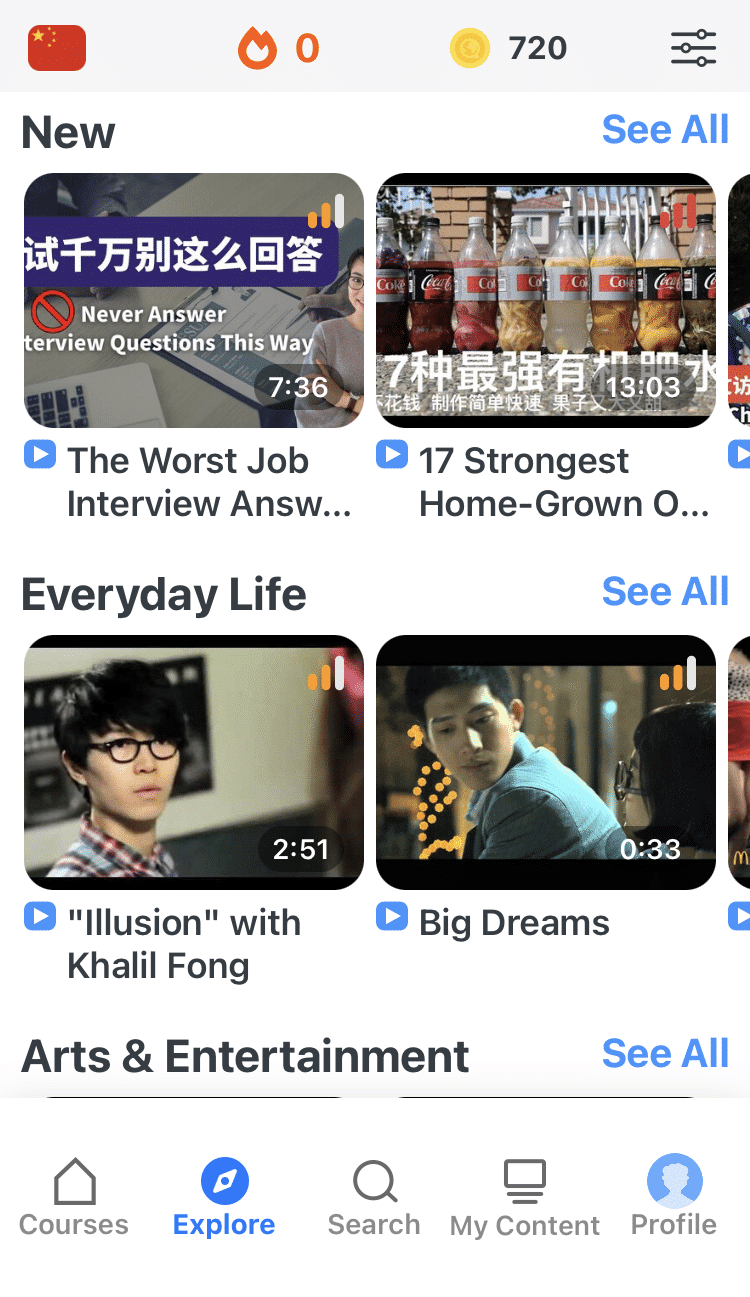
FluentU App Browse Screen
FluentU brings these native Chinese videos within reach via interactive captions. You can tap on any word to instantly look it up. All words have carefully written definitions and examples that will help you understand how a word is used. Tap to add words you'd like to review to a vocab list.
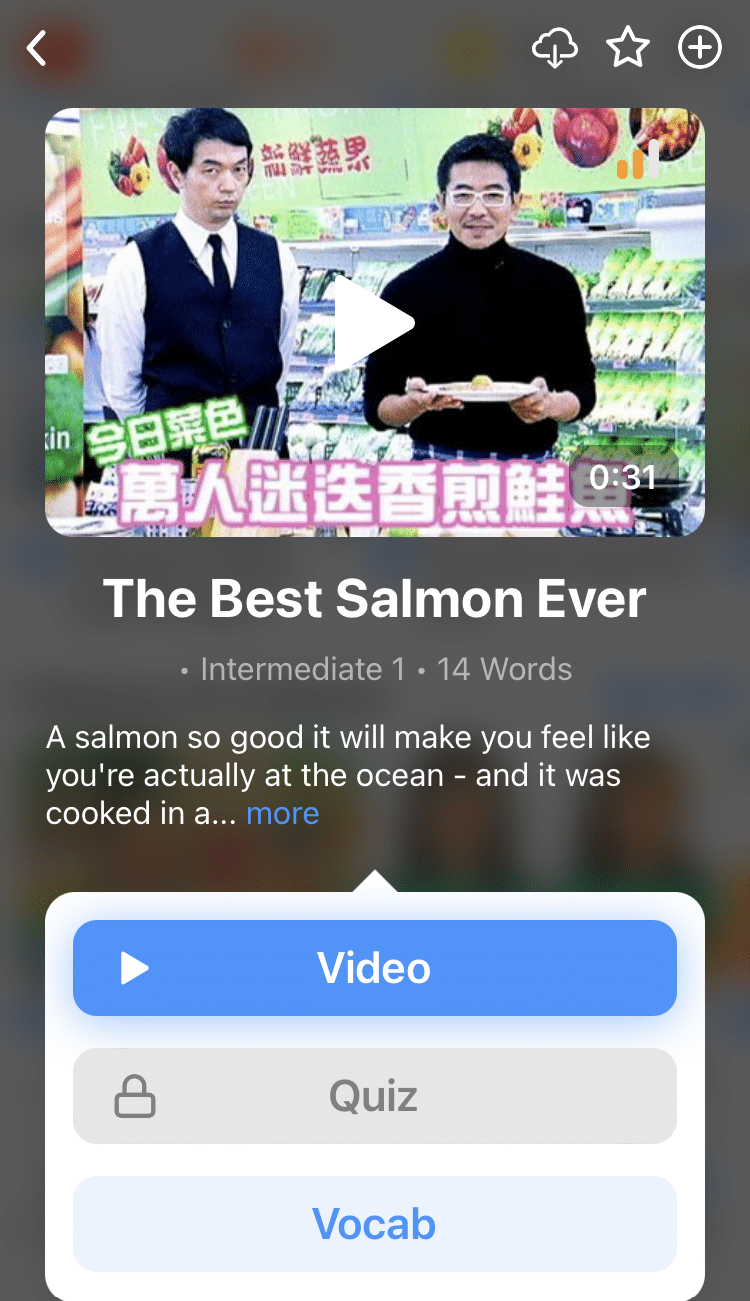
Interactive Transcripts on FluentU
FluentU's Learn Mode turns every video into a language learning lesson. You can always swipe left or right to see more examples for the word you're learning.
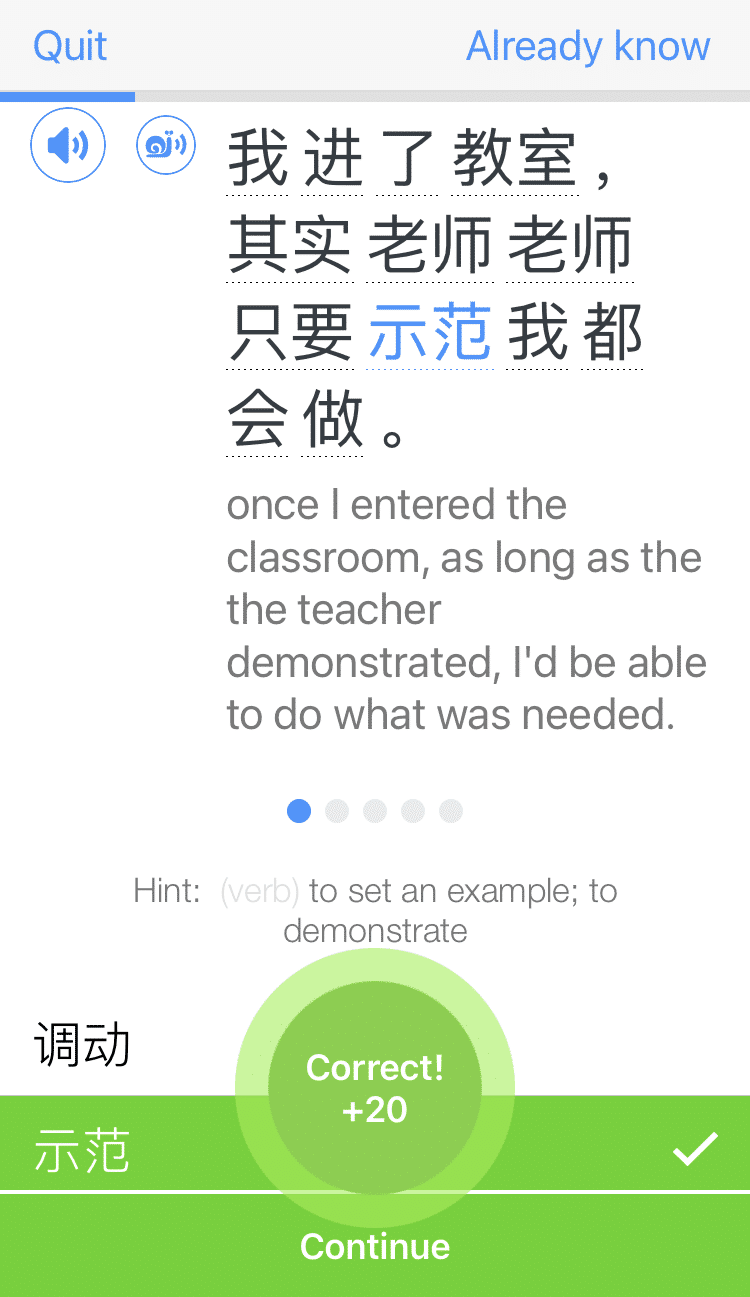
FluentU Has Quizzes for Every Video
The best part is that FluentU always keeps track of your vocabulary. It customizes quizzes to focus on areas that need attention and reminds you when it’s time to review what you’ve learned. You have a 100% personalized experience.
Start using the FluentU website on your computer or tablet or, better yet, download the FluentU app from the iTunes or Google Play store. Click here to take advantage of our current sale! (Expires at the end of this month.)
Enter your e-mail address to get your free PDF!
We hate SPAM and promise to keep your email address safe

All Subjects
Unit 3 Overview: Influences of Beauty and Art
1 min read • june 18, 2024
user_sophia9212
Introduction to Unit 3
Welcome to our overview of Unit 3 for the AP Chinese exam! In this unit, we will be exploring the various ways in which beauty and art have influenced Chinese culture throughout history. From ancient Chinese poetry and painting, to music and performance arts, we will delve into the rich and diverse cultural traditions that have shaped the country's artistic landscape. In this unit, we will also be studying how beauty and art intersect with other areas of Chinese life, such as philosophy, politics, and social norms. Whether you are a student taking the AP Chinese course, or simply someone interested in learning more about Chinese culture, we hope that this overview will provide you with a deeper understanding and appreciation of the enduring impact of beauty and art in China.
Unit 3 Essential Questions
STUDY TIP: Use the following essential questions to guide your review of this entire unit. Keep in mind, these are not meant to be practice essay questions. Each question was written to help you summarize the key concept.
The main topic of this unit is exploring how beauty and art influence the Chinese-speaking communities. Beauty and Aesthetics will be the main focus, although some previous themes mentioned make a reappearance.
As you work through this unit, think about these questions:
- How do ideals of beauty and aesthetics influence daily life? (审美和美学的理想是怎么影响到日常生活?)
- How does art both challenge and reflect cultural perspectives? (艺术是如何又反对又反映文化观点?)
- How do communities value beauty and art? (社区是如何看待美和艺术?)
- How is art used to record history? (艺术是如何用来记录历史的?)
Past Free-Response Questions from Unit 3 Overview: Influences of Beauty and Art
Note: Many free-response questions draw from information and vocabulary from multiple units and don’t fit neatly into one unit only. You will likely see them in other unit overviews as well.
Interpersonal Writing: Email Response
2008 Interpersonal Writing: Email Response - Inviting a friend to a classical music festival
2007 Interpersonal Writing: Email Response - Choosing an extracurricular activity (tennis versus dance)
Interpersonal Speaking: Conversation
2022 Interpersonal Speaking: Conversation - Art
2017 Interpersonal Speaking: Conversation - Applying for a study abroad program in Beijing, China
2015 Interpersonal Speaking: Conversation - Chinese club’s annual field trip
2014 Interpersonal Speaking: Conversation - Applying to the president of your school’s Chinese painting and calligraphy club
2013 Interpersonal Speaking: Conversation - Volunteering at the library
2012 Interpersonal Speaking: Conversation - Leisure activities
2011 Interpersonal Speaking: Conversation - Organizing/volunteering at Chinese cultural week
Presentational Speaking: Cultural Presentation
2021 Presentational Speaking: Cultural Presentation - Chinese culture (Chinese characters, Chinese martial arts, Chinese painting, etc.)
2015 Presentational Speaking: Cultural Presentation - Characteristic features of Chinese language (characters, tones, dialects, homophones, etc.)
2014 Presentational Speaking: Cultural Presentation - Chinese-language movie (一个都不能少 (Yīgè dōu bùnéng shǎo, Not one less), 洗澡 (Xǐ zǎo Shower), 活着 (Huózhe, To Live/Lifetimes), 饮食男女 (Yǐn shí nán nǚ, Eat Drink Man Woman), etc.)
2011 Presentational Speaking: Cultural Presentation - Chinese leisure activity (martial arts, Chinese chess, karaoke, table tennis, etc.)
2010 Presentational Speaking: Cultural Presentation - Chinese celebrities (Yao Ming, Michelle Kwan, Yo-yo Ma, Jackie Chen, etc.)
2009 Presentational Speaking: Cultural Presentation - Chinese art form (calligraphy, Beijing Opera, paper cutting, etc.)
## 3.1 Chinese Visual and Performing Arts
- Peking opera (also known as Beijing opera) is a traditional Chinese form of theater that combines music, vocal performance, mime, dance, and acrobatics
- It originated in the late 18th century and evolved into a more structured form in the 19th and 20th centuries
- Peking opera is an important part of Chinese culture and entertainment and has a wide range of characters including heroes, villains, and comedic figures
- Peking opera has a complex system of vocalization and distinct hand gestures and body movements
- Performers wear elaborate costumes and makeup, with each character having a specific style that conveys their personality and role in the story
- The colors of the costumes and makeup often have symbolic meanings in Peking opera
- Examples of common color symbols include white for malevolence, yellow for cruelty, green for violence, black for neutrality, and red for bravery and good fortune
- Peking opera performances typically include singing, dialogue, and action scenes, and may be accompanied by traditional Chinese instruments
- Peking opera has influenced other forms of Chinese entertainment and has a significant cultural and historical significance in China
- Other forms of Chinese visual and performing arts include traditional Chinese dance, traditional Chinese theater, and traditional Chinese acrobatics
3.2 Chinese Music and Painting
- Chinese music and painting have played a role in both personal and public identities in China
- Chinese traditional music includes classical, folk, and opera styles, and is played on a variety of instruments
- Traditional Chinese instruments are divided into categories called 八音 (Silk, Bamboo, Wood, Stone, Metal, Clay, Gourd, and Skin) and include the 二胡, 古筝, 琵琶, 笛子, and 萧
- Modern music in China includes genres such as C-pop , hip hop, rock, and music from other countries, and popular artists include 薛之谦, 周杰伦, 邓紫棋 (G.E.M.), 毛不易, and TFBoys
- Chinese painting has a long history and includes styles such as traditional Chinese landscape painting, ink wash painting , and modern Chinese painting
- Traditional Chinese painting techniques include the use of brush, ink, and paper, and often depict subjects such as landscapes, animals, and figures
- Modern Chinese painting includes a variety of styles and techniques, and may incorporate elements of Western art
- Chinese calligraphy is the art of writing Chinese characters and includes styles such as regular script, cursive script, and seal script
- Chinese literature includes works such as poetry, novels, and plays, and has a long history dating back to ancient China
- Chinese film is a popular form of entertainment in China and includes both domestic and international films
3.3 Chinese Beauty Ideals and Pop Culture
- Chinese beauty standards differ from Western standards, with a preference for fair skin, double eyelids, and certain facial features
- The use of skin-whitening products, including dangerous ingredients such as mercury, is prevalent in China
- The preference for fair skin is reflected in limited makeup shade ranges and the prevalence of brightening creams
- A common surgery in China is blepharoplasty , which creates double eyelids to make the eye appear larger
- Being extremely thin is also desired in China, with a limited size range in clothing, especially for women
- Fashion trends for women in China often follow an innocent and angelic look, while men tend to wear outfits that make them appear sophisticated or sporty
- Famous fashion brands are popular in China and there is a significant knockoff industry for these brands
- It is important to remember not to modify oneself or one's body to fit cultural norms, and to understand and respect cultural differences while also valuing self-acceptance and self-love.
- Popular Chinese TV shows include "Keep Running," "Happy Camp," "The Rap of China," "Where Are We Going, Dad?", "The Voice of China," and "Street Dance of China"
- Famous Chinese singers include Jay Chou, Wang Leehom, and Eason Chan
- Popular Chinese TV dramas include "The Untamed," "Eternal Love," and "Story of Yanxi Palace"
- Chinese internet culture includes popular social media platforms such as Weibo and Bilibili
3.4 Chinese Poetry and Architecture
- Chinese poetry dates back to the Shang Dynasty (1600-1046 BC) and has a rich tradition that has influenced literature and art around the world.
- Chinese songs have a similarly long history and have played a central role in the country's cultural life.
- The Book of Songs/Classic of Poetry (诗经(shījīng)) is the first book in China containing poems and includes poems written from the 11th century BCE and the 7th century BCE.
- Poetry in China had its Golden Age during the Tang dynasty (618 CE-907 CE). Poetry was required for the civil service exam, known as the Imperial examination system (科举制度(kējǔ zhìdù)).
- A collection of the most popular poems during the Tang dynasty is called the Three Hundred Tang Poems (唐诗三百首(tángshī sānbǎi shǒu)).
- During the Song dynasty (960 CE-1279 CE), many poems were based on previous rhythms and tunes, known as Cí (词(cí)).
- Chinese architecture, with its distinctive style and use of materials, has been recognized as a unique form of art for centuries and has had many influences on other countries in South Asia.
- Famous Chinese museums, such as the Palace Museum in Beijing and the Shanghai Museum , showcase the country's rich cultural heritage.
- Chinese architecture is characterized by its use of timber framing, painted decorations, and emphasis on symmetry and balance.
- The Forbidden City in Beijing is an example of Chinese imperial palace architecture and is a World Heritage Site. It was the Chinese imperial palace from the Ming dynasty to the end of the Qing dynasty.
- The Great Wall of China is another famous example of Chinese architecture and is a World Heritage Site. It is a series of fortifications made of brick, tamped earth, and other materials that were built along the historical northern borders of China.
- The Shanghai Tower is a notable example of modern Chinese architecture, standing at 632 meters tall and featuring a twisted design.
- Traditional Chinese architecture includes the use of wooden structures, red and yellow colors, and complex decorative designs.
- Modern Chinese architecture includes a mix of traditional and Western styles, with a focus on functionality and the use of modern materials.
Key Terms to Review ( 19 )
© 2024 fiveable inc. all rights reserved., ap® and sat® are trademarks registered by the college board, which is not affiliated with, and does not endorse this website..

COMMENTS
When opening your presentation in Chinese, remember to start by expressing thanks to the host of the event and to the previous speakers. If you are at an event or meeting that has distinguished guests, it is also worth expressing thanks to them too. For example, a good way to start is:
The power of preparation. We all know that winging it is rarely a winning strategy, especially with the added challenge of a presentation in Chinese. Remember that how you act during your presentation differs from how you act at Chinese business dinners. To really ace your Chinese business presentation, preparation is your BFF.
Like the common structure of your other presentation. You would firstly say Hi, "大家好,我是**( dà jiā hǎo,wǒ shì **)"Good morning/afternoon everyone, my name is **. If you are new to people, introduce yourself by giving interesting take away message. If you want to make business with someone in China, you should probably ...
Some basic tips on how to give a presentation at a Chinese company. To learn more, including all the Chinese phrases in this video, check out the full articl...
Learn Chinese vocabulary you can use for preparing a presentation. In this FREE ChineseClass101.com lesson, you learn the words and get translations and audio lessons. Hallo, Pooh, you're just in time for a little smackerel of something. Lessons. Lesson Library Newest Lessons Favorite Lessons.
Click the (+) icon in the lower right of the window. This will edit the display language of PowerPoint only. Melanie Weir/Business Insider. 6. Select "Microsoft PowerPoint" from the "Application ...
Tips for a Successful Chinese Presentation. Tip 1: Keep It Short and Impactful. Tip 2: Use Presentable Slides and Visuals. Tip 3: Translate the Presentation. Text Expansion. Speaker's Notes. Graphics. Screen Captures. Tip 4: Hire Simultaneous Interpreters.
https://bit.ly/3vWHM9g ← if you want to learn more vocabulary, phrases, and example sentences you can use in real-life situations, click here to download you...
To start, open PowerPoint and select File > Options. In the "PowerPoint Options" window, select "Language" on the left. On the right, choose a new language in the "Office Display Language" section and press the "Set As Preferred" option. This will determine the language used for menus and buttons. Next, choose a new proofing language in the ...
1. Open the new document in PowerPoint. 2. Go to the bottom of the software and click on the language option in the left area. You can also go to the review tab, then language, and click on set test language. 3. In the language box, several options will appear. You have to click on Chinese. Save the changes.
As you speak, Presentation Translator displays subtitles directly on your PowerPoint presentation in any one of more than 60 supported text languages. This feature can also be used for audiences who are deaf or hard of hearing. Up to 100 audience members in the room can follow along with the presentation in their own language by downloading the ...
Conversely, if you are writing within a Chinese context-as a member of a Chinese company, for example-the Chinese norms may apply. In either case, if you are writing to a Chinese audience, apply the information on style and social consdierations below to the standard that you choose. Check with colleagues for the standard practices of your company.
First we went from components to characters. Next, we are going from characters to words. Although there are a lot of one-character words in Chinese, they tend to either be classically-rooted words like "king" and "horse" or grammatical particles and pronouns. The vast majority of Chinese words contain two characters.
Chinese, the Han language, is the predominant language in China spoken by more than 93% of the population.The Chinese language roughly comprises ten main dialects: Northern Mandarin, Southwestern Mandarin, Eastern Mandarin, Xiang, Gan, Kejia, Wu, Northern Min, Southern Min, and Yue (Cantonese).Generally speaking, the writing system is identical in all dialects; however, the grammatical ...
In Chinese writing, you need to learn the strokes and strokes orders first. Only then, you will know how to write Chinese characters in the correct way. After that, you also need to study the radicals and the logic behind them. You can also make good use of pictograms image to help you remember the characters easily.
Two assigned presentation tasks per unit. Learn How To Write Chinese Characters. This course will also teach you how to write Chinese characters, each topic 2 lets you follow along with our video and practice writing on a downloadable writing sheet. As a beginner Chinese learner we believe learning characters and how to write characters is ...
To unlock all Chinese lessons like this video, you can enroll in our EverydayChinese101 Course here: https://www.everydaychinese.com/everyday-chinese-101/Don...
Greetings and self-introductions are the cornerstone of effective communication in any language. In Mandarin Chinese, understanding how to greet someone and introduce yourself can open doors to meaningful interactions and cultural connections. In this post, we'll explore the fundamental basics of greetings and self-introduction in Chinese, equipping you with the essential phrases to start ...
Here are some basic rules: Show pictures of people you worked together with. Show pictures of groups while you organized events. Show pictures of the panels that run events. Show your partners ...
1) Hello, It's nice to meet you. Hello and Nice to meet you in Chinese are a must-know phrases. And any introduction will probably will start with these words. Hello, it's nice to meet you. nínhǎo , hěn gāoxìng jiàn dào nǐ. 您好,很高兴见到你。.
This community is intended for those with an interest in discussing, reading, or translating Classical Chinese (a.k.a. Literary Chinese/Sinitic, or 古文/文言文) texts or analyzing historical Chinese linguistics.
PRESENTATION translate: 演講, 報告,演講,陳述, 授予,頒發, 外觀, 外觀;呈現方式;外貌. Learn more in the Cambridge English-Chinese traditional Dictionary.
Simple Chinese Greetings to Introduce Yourself. The basic Chinese greeting is a well-wish, using the word 好 ( hǎo) — good. Before saying hǎo, you can insert a time of day or a fitting pronoun. The standard greeting is 你好 ( nǐ hǎo) — hello, nǐ meaning "you.". [Personal pronoun] hǎo:
2011 Presentational Speaking: Cultural Presentation - Chinese leisure activity (martial arts, Chinese chess, karaoke, table tennis, etc.) ... Chinese calligraphy is the art of writing Chinese characters and includes styles such as regular script, cursive script, and seal script; Chinese literature includes works such as poetry, novels, and ...